#material experimenting structure combination
Explore tagged Tumblr posts
Text
Types of Writers

Generally, writers fit into one of 2 categories: fiction and nonfiction. Within those two categories, there are many different writing styles.
From fiction writers who create works of imagination to business journalists who report on breaking news, writers use different types of writing to achieve specific goals.
Novelist: A novel is a long piece of fiction, typically more than 40,000 words. Novels often include complex story arcs with multiple characters and span genres such as romance, science fiction, and historical fiction. Novelists are people who write novels; You can be a career novelist or write novels outside of your day job. Novelists generally fall into two categories: plotters—who meticulously plan the elements of their storyline and characters before starting; and pantsters—who are more spontaneous and “fly by the seat of their pants.”
Poet: Poets are writers of poems— a form of literature that conveys a thought, describes a scene, or tells a story in a concentrated, lyrical arrangement of words. Poetry can be structured, with rhyming lines and meter, or freeform (which follows no formal structure).
Songwriter: Songwriters craft lyrics that are set to music. A songwriter may be employed by a musician to provide lyrical accompaniment to a song, or they may write both the lyrics and musical notation.
Playwright: Playwrights craft stories that performers act out on a theater stage. The market for aspiring playwrights is competitive, but for those wishing to see their stories come to life, playwriting can be a gratifying experience.
Short story writer: Short stories are concise pieces of writing that tell a story in less time than a novel. Short stories are often published in magazines or compiled together in anthologies. The average short story runs anywhere from 5,000 to 10,000 words but can be anything above 1,000 words. Flash fiction is a short story that is 500 words or less.
Screenwriter: Screenwriters write original scripts for TV shows and movies. They may also write an adapted screenplay based on a book, story, article, or some other source material. Screenplays follow a specific format, and they tend to adhere to three-act structure.
Blogger: Bloggers self-publish content online. Though not exclusive to non-fiction writing, blogs tend to provide curious readers with fact-based knowledge on various topics, including food, travel, entertainment, and technology. Whether you’re a creative writer looking for an easy way to publish stories online or an entrepreneur looking for a way to promote your business, learning how to craft a blog post to reach your target audience successfully is a valuable skill.
Business writer: Most business writers work for newspapers or magazines that publish content for specific industries. Business writing can be a profitable form of writing if you’ve got a knack for networking and in-depth knowledge of industry-related terminology and concepts.
Copywriter: Copywriting involves writing copy for marketing and advertising purposes. Copywriters can be in-house employees at a company or advertising firm, or freelancers contracted to create copy.
Ghostwriter: Ghostwriters specialize in writing for other people. This requires the unique ability to be able to write convincingly in another person's tone of voice. Ghostwriters work with their clients— such as high-ranking government officials and media personalities—to craft a narrative and tell their story in the first person.
Journalist: Journalists write everything from op-eds to news stories. There are many kinds of journalistic writing; for example, a reporter uses an expository style to report facts on a news story. On the other hand, a features writer or editorial writer may use more a persuasive tone and share their point of view to influence an audience on a particular issue or topic.
Nonfiction book writers: Nonfiction is a popular writing form that combines in-depth research with compelling writing prowess. Common nonfiction formats include autobiographies, biographies, scientific writing, and more.
Technical writer: Technical writers are often in-house employees for businesses and corporations. Technical writing involves producing copy for instructional manuals and system documentation. This kind of work often requires the writer to have hyper-specific knowledge of a given field or industry.
Translator: To be a translator, you must speak two or more languages fluently and be able to accurately translate one to another. Translators work across numerous fields and have different specialties—you can be a translator for a technical manual, a novel, or even poetry.
Source ⚜ More: Writing Notes & References ⚜ Writing Resources PDFs
#writing#writing reference#writeblr#literature#dark academia#writers on tumblr#spilled ink#writing prompt#creative writing#light academia#writing ideas#writing inspiration#writing resources
88 notes
·
View notes
Text
The Sun Through the Degrees
The Sun represents your core identity, life force, purpose, and ego. The specific degree of the Sun in your birth chart adds extra depth to your personality, revealing how you express your individuality and approach life.
0° Sun – The Pure Self
• Radiates raw, unfiltered energy.
• Strong sense of identity but may act impulsively.
• Has a natural leadership presence.
1° Sun – The Pioneer
• Courageous and ready to initiate new paths.
• Highly independent and self-reliant.
• Can be impatient or impulsive.
2° Sun – The Builder
• Grounded and focused on long-term stability.
• Prefers a steady approach to life.
• Can be stubborn but dependable.
3° Sun – The Expressive Spirit
• Charismatic and lively, enjoys self-expression.
• Loves being noticed and recognized.
• Needs to balance confidence with humility.
4° Sun – The Structured Leader
• Organized and values tradition.
• Takes responsibility seriously.
• Can be rigid in their beliefs.
5° Sun – The Bold Creator
• Passionate about making an impact.
• Highly creative and enjoys taking risks.
• Needs to control ego-driven tendencies.
6° Sun – The Perceptive One
• Highly intuitive and emotionally aware.
• Seeks depth and meaning in life.
• Can be overly sensitive to criticism.
7° Sun – The Spiritual Seeker
• Deeply connected to spiritual or philosophical beliefs.
• May feel like they have a bigger mission in life.
• Can be detached from practical concerns.
8° Sun – The Powerful Influencer
• Naturally magnetic and authoritative.
• Draws people in with confidence and presence.
• Needs to be mindful of power struggles.
9° Sun – The Enthusiastic Adventurer
• Loves exploring new ideas, places, and experiences.
• Optimistic and full of energy.
• Needs to learn patience and commitment.
10° Sun – The Determined Achiever
• Hardworking and committed to success.
• Takes pride in accomplishments.
• Can be too focused on material success.
11° Sun – The Visionary
• Thinks ahead and embraces innovation.
• Often feels different from the crowd.
• Needs to ground ideas into reality.
12° Sun – The Emotional Intuitive
• Deeply sensitive and emotionally aware.
• Can easily pick up on others’ energies.
• Needs to balance emotions with logic.
13° Sun – The Transformational Leader
• Goes through major personal transformations in life.
• Highly intense and passionate.
• Needs to learn surrender and adaptability.
14° Sun – The Magnetic Personality
• Naturally draws people in with charm and warmth.
• Has a strong presence but can be overwhelming.
• Needs to ensure authenticity in self-expression.
15° Sun – The Balanced Individual
• Strives for harmony and fairness.
• Can see multiple perspectives in a situation.
• Needs to be decisive and firm.
16° Sun – The Purpose-Driven Soul
• Feels called to do something meaningful.
• Often takes on leadership or guiding roles.
• Needs to ensure they follow their own path, not others’.
17° Sun – The Competitive Spirit
• Loves a challenge and thrives in competition.
• Can be extremely determined and ambitious.
• Needs to learn humility in victory and grace in defeat.
18° Sun – The Deep Thinker
• Reflective and highly intellectual.
• May take a philosophical approach to life.
• Needs to take action instead of overanalyzing.
19° Sun – The Risk-Taker
• Bold, adventurous, and always seeking excitement.
• Thrives on change but must avoid recklessness.
• Needs to commit to something long-term.
20° Sun – The Hardworking Visionary
• Combines discipline with big-picture thinking.
• Highly focused on making an impact.
• Needs to find balance between work and personal life.
21° Sun – The Creative Thinker
• Expresses themselves through art, ideas, or innovation.
• Has a natural talent for communication.
• Needs to ensure they follow through on ideas.
22° Sun – The Master Strategist
• Highly intelligent and calculated in their approach.
• Can be a great planner or organizer.
• Needs to be mindful of over-controlling tendencies.
23° Sun – The Confident Leader
• Natural ability to lead and inspire others.
• Highly self-assured and ambitious.
• Needs to remain humble and open-minded.
24° Sun – The Passionate Creator
• Puts their heart into everything they do.
• Has a strong emotional connection to their work.
• Needs to manage intense emotional highs and lows.
25° Sun – The Loyal Defender
• Extremely dedicated to loved ones and personal beliefs.
• Can be protective and stand up for others.
• Needs to ensure they don’t become overly possessive.
26° Sun – The Hidden Power
• Has a quiet strength that others may not see immediately.
• Doesn’t always seek the spotlight but holds great influence.
• Needs to trust their abilities and step forward when needed.
27° Sun – The Dreamer in Action
• Inspired by big visions and spiritual ideas.
• Has a deep sense of purpose but must stay practical.
• Needs to balance imagination with grounded action.
28° Sun – The Worldly Explorer
• Drawn to different cultures, philosophies, and ideas.
• Always seeking new knowledge and experiences.
• Needs to find stability amidst constant change.
29° Sun – The Karmic Leader
• Carries deep wisdom and lessons from past lifetimes.
• May feel a strong sense of destiny or mission.
• Needs to overcome final challenges before stepping fully into their power.
#astro notes#astrology#birth chart#astro observations#astro community#critical degrees#astrology degrees#astrology observations
2K notes
·
View notes
Text
Saturn in the Signs
paid readings | Masterlist
ᡣ𐭩 Please support me by reposting, liking, following me and commenting your placement. Saturn represents resitictions, delays and obsticals however it's precious as it represents dicipline and what comes from struggle results in a beautiful flower of growth.


0º is the degree which doesn't have a coresponding sign assigned to it. It's a fresh new degree and will amplify the themes of the sign that it's in
Aries (1,13,25º) This placement often restricts decisions, self-assertion, and independence. Natives may battle with impatience, fear of authority figures, or a fear of taking charge, but by practicing self-control and confronting these concerns they develop confidence and the ability to effectively apply their pioneering spirit.
Taurus (2, 14, 26°) Lessons pertaining to financial stability, values, and material security are particularly crucial when Saturn is in Taurus. Early problems or worries about money and belongings may surface, but these people can develop long-term prosperity and a strong sense of practical self-worth with hard work and a targeted approach.
Gemini (3, 15, 27°)When Saturn is in Gemini, intelligence, education, and communication are highly valued. Individuals may have difficulty expressing themselves clearly, struggle with disorganised ideas, or feel ashamed of their intelligence. Conducting thorough research, cultivating a disciplined learning style, and having the capacity for accurate and clear communication are all necessary for mastery.
Cancer (4, 16, 28°)This placement covers topics like emotional stability, family, and roots. Early experiences with emotional control or a strong sense of familial duty may have taken place. Being a reliable anchor for loved ones requires developing a strong emotional foundation, learning self-care skills, and establishing appropriate boundaries at home.
Leo (5, 17, 29°) The ego, creativity, and self-expression are all hampered by Saturn in Leo. People may experience pride issues, fear criticism of their skills, or feel constrained in their ability to express who they truly are. The journey involves developing genuine confidence that is independent of outside validation as well as learning how to communicate their unique talents in an honest and modest way.
Virgo (6, 18° ) When Saturn is in Virgo, the emphasis shifts to service, daily routines, and perfectionism. Anxiety about details, self-criticism, or feeling overburdened with obligations are examples of problems. Developing effective systems, embracing failure, and finding fulfilment in applying effort and hard work to make a meaningful impact are all steps on the path to mastery.
Libra (7, 19°) Because it is exalted in Libra, Saturn performs well there. The primary subjects of this placement are justice, fairness, and relationships. Natives learn about commitment, collaboration, and diplomacy. Their consistent pursuit of integrity and balance in all of their relationships solidifies their reputation for justice and moral behaviour.
Scorpio( 8, 20°) We can learn a lot about transformation, power, control, and shared resources from Saturn in Scorpio. There may be ingrained worries about vulnerability, trust, or loss. Confronting shadow elements, building resilience, and learning how to handle difficult emotional and financial circumstances with integrity and inner strength are all part of the process.
Sagittarius (9, 21°) By combining a methodical structure with a philosophical pursuit of truth, Saturn in Sagittarius promotes a serious approach to higher education and the development of strong moral principles. This placement encourages deliberate exploration and a grounded optimism as individuals balance their need for independence with a commitment to responsible, meaningful growth.
Capricorn (10, 22º) Because Saturn rules this position, it is ideal for ambition, self-control, and financial success. Natives frequently take on significant responsibilities and are typically very responsible, dedicated, and driven to succeed. Despite their enormous potential, they still need to learn how to balance their personal and professional lives, control their ambition, and remain flexible.
Aquarius (11, 23°) Saturn in Aquarius emphasises cooperation, generosity, and originality. Individuals may have trouble making friends, feel responsible for social problems, or find it difficult to fit into established systems. The lesson's primary goals are to encourage genuine, meaningful change, create strong, accountable communities, and present unique ideas to the group.
Pisces (12, 24°) Teachings about compassion, spirituality, and establishing boundaries are particularly crucial when Saturn is in Pisces. Natives may choose to leave, feel like martyrs, or struggle to set boundaries. Mastery includes establishing healthy emotional boundaries, integrating spiritual knowledge with pragmatic realities, and identifying systematic ways to demonstrate empathy and service.

DISCLAIMER: This post is a generalisation and may not resonate. I recommend you get a reading from an astrologer (me). If you want a reading from me check out my sales page.
@astrofaeology private services 2025 all rights reserved
502 notes
·
View notes
Note
Another question, how did the tria prima relate to the human body/human experience? Any relation to homonculi? Homonculus? I dont know how to spell it im lazy lmaooooooo
Practical Hermetica conceptualized the body as earthen, the spirit as fiery, and the mind as both airy and watery, which acted as an insulator between the body and spirit. Can't have the spirit burning your body, or your body staunching your spirit.
Skip ahead about 900 years and Arabic alchemists developed the sulphur-mercury theory of matter. The idea being that all metals were fundamentally some combination of a Sophic Mercury (thing that is changed) and a Sophic Sulphur (thing that changes).
Skip ahead about 500 more years are you get to Paracelsus, who also adds Salt, which is the dross given off by the process of change, and the material that structures it. (Think wood burning to ash).
Skip ahead about 100 more years to Basil Valentine and the rosicrucisns, who thought this all would make a good metaphor for the soul. (Paracelsus also thought that, but in a more biological way and the rosicrucian literature was highly Swagful)
149 notes
·
View notes
Text
✨ Tarot Numerology ✨

ONE
The Leader
Numerology Meaning:
The number 1 is about initiation, originality, and stepping out into the world with purpose. As the first step out of infinite potential (zero), 1 stands alone, symbolizing individual identity, willpower, and the courage to create. Historically, 1 is the mark of primal force—the singular essence from which everything flows. In numerology, it’s the energetic core of independence, ambition, and the spark to innovate.
Tarot Perspective:
In the Tarot’s pip cards, the Aces of each suit carry this singular, potent energy. They represent pure forms of the suit’s element—raw potential that holds all possibilities within it, waiting to be expressed. Just as 1 represents an unshaped force, each Ace is a pure idea, whether in action (Wands), emotions (Cups), intellect (Swords), or physicality (Pentacles). These Aces invite us to seize opportunities with confidence and be bold in our pursuits.
TWO
The Diplomat
Numerology Meaning:
The number 2 brings balance, harmony, and relational awareness. It’s about duality—the first reflection, the dance between two forces, and the desire for unity and partnership. Historically, 2 has symbolized the divine feminine, yin energy, and the space of receptivity. It’s a number of gentle strength, peacekeeping, and the intuitive drive to connect.
Tarot Perspective:
In the pip cards, the Twos depict the ways we connect, reflect, and balance in each element. Whether it’s a decision (Swords), a new partnership or harmony in emotions (Cups), steady progress in material pursuits (Pentacles), or a balancing act in action (Wands), the Twos reveal how we respond to relationships and decisions. Like the number 2, these cards emphasize the quiet strength in collaboration and the subtle wisdom of patience and timing.
THREE
The Creator
Numerology Meaning:
The number 3 is a dynamic, expressive force of creativity and expansion. It’s the fusion of the initial two energies (1 and 2) into a creative whole, representing communication, growth, and joyful expression. Historically, 3 is connected to the principles of birth and development, a number that thrives in social and creative environments, promoting joy and fertility.
Tarot Perspective:
The Threes in the pip cards embody this energy of creation and growth. In Wands, it’s the first steps toward actualizing dreams; in Cups, it’s celebration and community; in Swords, it’s the understanding gained through pain or loss; in Pentacles, it’s teamwork and craftsmanship. Each suit shows how 3 encourages us to move beyond ourselves, combining effort with passion to shape something new.
FOUR
The Foundation
Numerology Meaning:
4 represents stability, structure, and reliability. In numerology, it’s associated with the four elements, directions, and seasons—grounding forces that bring order to life. 4 is practical, focused, and foundational, favoring systems, organization, and discipline.
Tarot Perspective:
The Fours in the pip cards manifest as the foundational aspects of each suit. In Wands, it’s the grounding of achievements; in Cups, it’s emotional stability or contemplation; in Swords, it’s rest and mental recovery; in Pentacles, it’s financial stability or holding on to resources. These cards show how 4’s stability brings a solid base to each element, though it sometimes carries a sense of inertia, requiring a conscious effort to move forward.
FIVE
The Adventurer
Numerology Meaning:
5 is the number of freedom, movement, and change. It introduces the unpredictable, challenging us to adapt and expand our horizons. Historically, 5 symbolizes humanity’s sensory experiences and the drive to explore. It thrives on energy, pushing limits, and living in a space of constant discovery and sometimes disruption.
Tarot Perspective:
The Fives in the pip cards embody this restless and sometimes chaotic energy. They represent conflict (Wands), emotional hardship (Cups), mental challenges (Swords), and financial strain or material lack (Pentacles). Each Five brings tension or discomfort, urging us to confront, question, and adapt. In this way, they reflect 5’s adventurous yet unpredictable spirit, which, while challenging, drives growth and resilience.
SIX
The Nurturer
Numerology Meaning:
6 is harmony, nurturing, and responsibility. It reflects compassion, community, and a balanced home life, often associated with service and love. Historically, 6 has been seen as the number of perfection and balance, promoting healing and relationships.
Tarot Perspective:
The Sixes in the pip cards capture themes of restoration and connection. Wands shows victory and public recognition, Cups delves into nostalgia and shared memories, Swords highlights journeys and transitions, and Pentacles reveals generosity and material support. These cards express 6’s nurturing energy, reminding us to cultivate harmony, support others, and seek peace within and around us.
SEVEN
The Seeker
Numerology Meaning:
7 is introspective, spiritual, and analytical. It represents the quest for deeper understanding and the mysteries of life. Historically revered as a sacred number, 7 embodies wisdom, inner strength, and a desire to understand the hidden truths.
Tarot Perspective:
In the pip cards, the Sevens show moments of introspection and the need to go beyond the surface. The Wands reflect perseverance despite challenges; the Cups present illusions and choices; the Swords show cunning or strategic thinking; the Pentacles emphasize patience and evaluation. Each suit’s Seven prompts us to dig deeper, calling for self-reflection, and urging us to align with our own truth.
EIGHT
The Achiever
Numerology Meaning:
8 is the number of material mastery, strength, and accomplishment. It’s associated with abundance, power, and the balancing of spiritual and material realms. Historically, 8 reflects infinity and the natural cycles of life, emphasizing responsibility and resilience.
Tarot Perspective:
The Eights in the pip cards reveal how each element achieves mastery and balance. In Wands, it’s momentum and fast-moving energy; in Cups, it’s emotional resilience and the courage to leave behind what doesn’t serve; in Swords, it’s mental entrapment that requires strength to overcome; in Pentacles, it’s diligent, focused work. These cards embody 8’s ambitious and disciplined energy, showing how mastery demands persistence and often involves sacrifice.
NINE
The Humanitarian
Numerology Meaning:
9 represents universal love, wisdom, and completion. It carries a sense of fulfillment, reflection, and the giving back of one’s learned insights to others. Historically, 9 has been seen as the number of the elder and the humanitarian, encouraging selflessness and empathy.
Tarot Perspective:
In the pip cards, the Nines reflect both the challenges and fulfillment of completion. Wands depict resilience despite near exhaustion; Cups offer emotional satisfaction and wishes fulfilled; Swords show anxiety and worry; Pentacles celebrate material success and independence. The Nines hold 9’s humanitarian spirit, reminding us to connect deeply with our experiences, learning and growing as we prepare to move forward.
TEN
The Whole
Numerology Meaning:
10 is a number of fulfillment, closure, and the start of a new cycle. It represents both the ending and beginning, incorporating the dynamism of 1 with the boundless nature of 0. Historically, 10 has been the number of the “great wheel,” symbolizing the completion of journeys.
Tarot Perspective:
In the pip cards, the Tens express the culmination of each suit’s journey. The Wands bring the weight of success and responsibility; Cups bring emotional fulfillment within family or community; Swords depict the finality of mental strain; Pentacles reflect the legacy of material wealth and stability. Each card carries the essence of 10 as a cycle that has reached fullness, preparing for a new phase with both the wisdom and challenges of what came before.
#learn tarot#tarot deck#tarot reading#tarot cards#tarotblr#tarotcommunity#tarot#witchblr#witchcraft#full moon#pagan#green witch#grimoirey#mine#foryourgrimoire#grimoire#online grimoire#magic#spell#new moon#divination#cartomancy#learn the tarot#learning astrology#learning#baby witch
162 notes
·
View notes
Text
Aspects of Saturn in the Natal Chart

☌ Saturn Conjunct Other Planets
Conjunctions can be both positive and negative. On the positive side, they combine the energies of the planets involved, enhancing their qualities and creating a powerful synergy. This can result in heightened strengths and abilities in the areas governed by the conjunct planets. On the negative side, conjunctions can amplify challenging traits, potentially leading to imbalances or conflicts if the combined energies are not well-integrated or harmonized.
Saturn Conjunct Sun
Saturn conjunct Sun brings a strong sense of responsibility and discipline. You are practical and ambitious, often striving for long-term goals with perseverance. This aspect enhances your ability to overcome obstacles and achieve success through hard work and dedication. It encourages you to develop a mature and realistic approach to life.
Saturn Conjunct Moon
Saturn conjunct Moon fosters emotional resilience and stability. You may experience challenges in expressing your emotions, but this aspect helps you build inner strength. It encourages you to face emotional difficulties with patience and discipline, ultimately leading to emotional maturity and a strong sense of self-reliance.
Saturn Conjunct Mercury
Saturn conjunct Mercury enhances your focus and analytical abilities. You are disciplined in your thinking and communication, often preferring structured and logical approaches. This aspect encourages you to develop patience and precision in your intellectual pursuits, leading to success through careful planning and diligent effort.
Saturn Conjunct Venus
Saturn conjunct Venus brings a serious and committed approach to relationships and finances. You value stability and responsibility in love and material matters. This aspect encourages you to develop lasting and meaningful connections through patience and effort, while also fostering a disciplined approach to financial security.
Saturn Conjunct Mars
Saturn conjunct Mars combines ambition with discipline. You are determined and persistent in pursuing your goals, often facing challenges with resilience. This aspect encourages you to channel your energy and drive in a focused and strategic manner, leading to long-term success through hard work and perseverance.
Saturn Conjunct Jupiter
Saturn conjunct Jupiter blends optimism with practicality. You balance expansive visions with disciplined effort, fostering steady growth. This aspect supports long-term success through strategic planning and perseverance, helping you achieve your ambitions with a practical approach.
Saturn Conjunct Uranus
Saturn conjunct Uranus blends tradition with innovation. You have a unique ability to balance structure with a desire for change. This aspect encourages you to integrate new ideas within established frameworks, leading to breakthroughs and progress through disciplined creativity.
Saturn Conjunct Neptune
Saturn conjunct Neptune combines realism with idealism. You have the ability to bring your dreams into reality through disciplined effort. This aspect encourages you to pursue your spiritual and creative goals with practicality and perseverance, fostering a grounded approach to your aspirations.
Saturn Conjunct Pluto
Saturn conjunct Pluto brings transformative power to your ambitions. You pursue your goals with intensity and depth, often facing profound challenges. This aspect encourages you to harness your inner strength and resilience to achieve significant personal and professional transformations.
⚹ Saturn Sextile Other Planets
Sextiles are positive aspects that encourage cooperation and the easy flow of energies between the involved planets. This harmonious connection facilitates smooth interactions and enhances the beneficial qualities of each planet, leading to supportive and constructive outcomes. The ease of this aspect promotes opportunities for growth, creativity, and positive developments in the areas influenced by the sextile.
Saturn Sextile Sun
Saturn sextile Sun supports your ambition with discipline and practicality. You are focused and determined, attracting opportunities for steady progress. This aspect encourages you to pursue your goals with a realistic and strategic approach, leading to long-term success through consistent effort.
Saturn Sextile Moon
Saturn sextile Moon brings emotional stability and resilience. You are able to handle emotional challenges with patience and discipline. This aspect encourages you to develop a mature and realistic approach to your emotions, fostering inner strength and emotional growth.
Saturn Sextile Mercury
Saturn sextile Mercury enhances your analytical and communication skills. You are disciplined in your thinking and prefer structured approaches to problem-solving. This aspect supports intellectual growth and success through careful planning and diligent effort in your pursuits.
Saturn Sextile Venus
Saturn sextile Venus brings opportunities for stable and committed relationships. You value responsibility and loyalty in love and material matters. This aspect encourages you to build lasting connections and achieve financial security through patience and disciplined effort.
Saturn Sextile Mars
Saturn sextile Mars provides opportunities for focused and strategic action. You are determined and persistent in pursuing your goals. This aspect supports your ambitions by encouraging you to channel your energy and drive in a disciplined manner, leading to long-term success.
Saturn Sextile Jupiter
Saturn sextile Jupiter blends growth with discipline. You attract opportunities through strategic planning and perseverance. This aspect supports steady progress and long-term success, helping you balance optimism with practical efforts to achieve your ambitions.
Saturn Sextile Uranus
Saturn sextile Uranus offers chances to integrate innovation within established frameworks. You balance tradition with a desire for change, attracting opportunities for breakthroughs. This aspect encourages disciplined creativity and progress through a strategic approach to new ideas.
Saturn Sextile Neptune
Saturn sextile Neptune enhances your ability to bring dreams into reality. You combine realism with idealism, pursuing your spiritual and creative goals with practicality. This aspect supports the manifestation of your aspirations through disciplined effort and a grounded approach.
Saturn Sextile Pluto
Saturn sextile Pluto brings transformative opportunities through disciplined effort. You approach your goals with intensity and depth, often achieving profound changes. This aspect encourages harnessing your inner strength and resilience to achieve significant personal and professional transformations.
□ Saturn Square Other Planets
Squares are negative aspects that create tension and challenges between the involved planets, prompting growth through conflict. This dynamic aspect often leads to struggles and obstacles that need to be overcome, pushing individuals to address and resolve the underlying issues. The friction generated by squares can be difficult to navigate, but it ultimately encourages personal development and resilience as one learns to balance and harmonize the conflicting energies.
Saturn Square Sun
Saturn square Sun creates tension between your ambitions and practical limitations. You may face challenges in balancing your goals with realistic efforts. This aspect encourages learning patience and perseverance, helping you overcome obstacles through disciplined and strategic planning.
Saturn Square Moon
Saturn square Moon can lead to emotional difficulties and feelings of restriction. You may struggle with expressing your emotions, but this aspect encourages developing emotional resilience and maturity. Learning patience and discipline helps you navigate emotional challenges.
Saturn Square Mercury
Saturn square Mercury may lead to challenges in communication and thinking. You might struggle with balancing your analytical abilities with practical considerations. This aspect encourages developing patience and precision in your intellectual pursuits, fostering growth through disciplined effort.
Saturn Square Venus
Saturn square Venus can result in challenges in relationships and finances. You may face difficulties in balancing your desires with practical needs. This aspect encourages learning patience and responsibility, fostering stable and committed connections through disciplined effort.
Saturn Square Mars
Saturn square Mars can create tension between your ambition and practical limitations. You may face challenges in balancing your drive with realistic efforts. This aspect encourages developing patience and strategic planning, helping you achieve long-term success through disciplined action.
Saturn Square Jupiter
Saturn square Jupiter creates tension between your expansive visions and practical realities. You may struggle with balancing optimism with realistic efforts. This aspect encourages learning patience and refining your approach, fostering long-term success through disciplined planning.
Saturn Square Uranus
Saturn square Uranus can bring challenges in balancing tradition with innovation. You may face disruptions and conflicts between established structures and new ideas. This aspect encourages developing patience and adaptability, fostering progress through a disciplined approach to change.
Saturn Square Neptune
Saturn square Neptune can lead to confusion and challenges in balancing dreams with practical goals. You may struggle with unrealistic expectations and idealistic pursuits. This aspect encourages finding clarity and realism in your pursuits, fostering growth through disciplined effort.
Saturn Square Pluto
Saturn square Pluto can create intense challenges and power struggles. You may face obstacles in achieving your ambitions due to conflicting desires and practical limitations. This aspect encourages transforming your approach and harnessing inner strength to overcome significant challenges and achieve growth.
△ Saturn Trine Other Planets
Trines are positive aspects that create a smooth and beneficial connection between the involved planets, enhancing talents and creating a sense of ease. This harmonious aspect facilitates the natural flow of energy, making it easier to express and develop the qualities associated with the planets. Trines often lead to emotional balance, inner harmony, and an overall sense of well-being, as the supportive nature of this aspect encourages the effortless integration of strengths and abilities.
Saturn Trine Sun
Saturn trine Sun brings a harmonious balance between ambition and discipline. You are focused and determined, often achieving success through steady and consistent effort. This aspect supports long-term goals and encourages a realistic and practical approach to your pursuits.
Saturn Trine Moon
Saturn trine Moon enhances your emotional stability and resilience. You handle emotional challenges with patience and maturity. This aspect supports a realistic and disciplined approach to your emotions, fostering inner strength and emotional growth.
Saturn Trine Mercury
Saturn trine Mercury boosts your analytical and communication abilities. You approach problem-solving with discipline and precision. This aspect supports intellectual growth and success through careful planning and a structured approach to your pursuits.
Saturn Trine Venus
Saturn trine Venus brings stability and commitment to your relationships and finances. You value responsibility and loyalty in love and material matters. This aspect supports building lasting connections and achieving financial security through disciplined effort and patience.
Saturn Trine Mars
Saturn trine Mars enhances your ambition and determination. You pursue your goals with focus and persistence, often achieving success through strategic actions. This aspect supports your ambitions by encouraging a disciplined and practical approach to your endeavors.
Saturn Trine Jupiter
Saturn trine Jupiter balances growth with discipline. You approach your ambitions with a realistic and optimistic mindset, supporting steady progress. This aspect fosters long-term success through strategic planning and perseverance, blending visionary goals with practical efforts.
Saturn Trine Uranus
Saturn trine Uranus enhances your ability to balance tradition with innovation. You integrate new ideas within established frameworks, leading to progress and breakthroughs. This aspect supports disciplined creativity and a strategic approach to embracing change.
Saturn Trine Neptune
Saturn trine Neptune boosts your ability to bring dreams into reality. You combine realism with idealism, pursuing your spiritual and creative goals with practicality. This aspect supports the manifestation of your aspirations through disciplined effort and a grounded approach.
Saturn Trine Pluto
Saturn trine Pluto brings transformative power to your ambitions. You pursue your goals with intensity and depth, often achieving profound changes. This aspect encourages harnessing your inner strength and resilience to achieve significant personal and professional transformations.
☍ Saturn Opposition Other Planets
Oppositions in astrology create a dynamic of tension and awareness between the energies of the planets involved. This aspect often highlights contrasting needs and urges individuals to find a balance between them. While oppositions can create challenges, they also provide opportunities for growth and integration as one learns to navigate the tension between opposing forces.
Saturn Opposite Sun
Saturn opposite Sun creates tension between your ambitions and practical realities. You may face challenges due to conflicting desires and limitations. Finding balance between your goals and realistic efforts is key, encouraging growth through learning from experiences and adapting your approach.
Saturn Opposite Moon
Saturn opposite Moon can create tension between emotional needs and practical considerations. You may face challenges in balancing your emotions with realistic expectations. This aspect encourages developing emotional resilience and maturity, fostering growth through disciplined effort.
Saturn Opposite Mercury
Saturn opposite Mercury can lead to conflicts between your analytical abilities and practical thinking. You may struggle with balancing your intellect with realistic considerations. This aspect encourages finding clarity and developing patience in your communication and intellectual pursuits.
Saturn Opposite Venus
Saturn opposite Venus creates tension between your desires and practical needs. You may face challenges in balancing relationships and material matters. This aspect encourages learning patience and responsibility, fostering stable and committed connections through disciplined effort.
Saturn Opposite Mars
Saturn opposite Mars can lead to conflicts between your ambition and practical limitations. You may struggle with balancing your drive with realistic efforts. This aspect encourages developing patience and strategic planning, helping you achieve long-term success through disciplined action.
Saturn Opposite Jupiter
Saturn opposite Jupiter creates tension between your expansive visions and practical realities. You may struggle with balancing optimism and realistic efforts. This aspect encourages learning patience and refining your approach, fostering long-term success through disciplined planning.
Saturn Opposite Uranus
Saturn opposite Uranus can bring tension between tradition and innovation. You may face conflicts between established structures and new ideas. This aspect encourages finding balance between stability and change, fostering growth through disciplined adaptability.
Saturn Opposite Neptune
Saturn opposite Neptune creates tension between your ideals and practical goals. You may struggle with balancing dreams and realistic efforts. This aspect encourages finding clarity and realism in your pursuits, fostering growth through disciplined effort and a grounded approach.
Saturn Opposite Pluto
Saturn opposite Pluto can bring intense challenges and power struggles. You may face obstacles in achieving your ambitions due to conflicting desires and practical limitations. This aspect encourages transforming your approach and harnessing inner strength to overcome significant challenges and achieve growth.
©️kleopatra45
#astrology#astrology community#astroblr#astrology readings#astro notes#astrology observations#astrology tumblr#houses in astrology#saturn in astrology#saturn
184 notes
·
View notes
Text
Keep It Eclectic

Eclecticism in witchcraft and magick refers to the practice of drawing from multiple traditions, spiritual paths, and systems of belief to create a personalized practice. In modern witchcraft, eclecticism plays a crucial role in making the craft more inclusive, adaptable, and meaningful to practitioners. Below are some of the key reasons why eclecticism is important in contemporary magickal practices.
Personalization and Authenticity
Modern witches often find that no single tradition fully resonates with their experiences, beliefs, or needs. Eclecticism allows individuals to:
• Craft a practice that aligns with their personal spirituality.
• Blend different traditions in a way that feels authentic and meaningful.
• Avoid dogma and rigid structures that may not fit their worldview.
For example, a practitioner may feel drawn to the herbal wisdom of traditional European witchcraft, the protective symbols of Hoodoo, and the lunar cycles of Wicca, forming a practice that uniquely reflects their path.

Accessibility and Inclusivity
Historically, many magickal traditions were closed to outsiders, limited to specific cultures, or hidden due to persecution. Today, eclectic witchcraft makes spirituality and magick more accessible by:
• Welcoming people from diverse backgrounds who may not have a direct lineage in a particular tradition.
• Allowing solitary practitioners to develop their own methods rather than requiring formal initiation.
• Encouraging respect for different cultural practices without enforcing exclusivity.
This inclusivity is especially important for witches who may not feel connected to a single cultural or religious identity but still seek a meaningful spiritual path.
Adaptability to Modern Life
Traditional magical systems were often developed in specific cultural and historical contexts. While valuable, some of their original practices may not be practical for modern practitioners. Eclecticism allows witches to:
• Integrate new knowledge, science, and technology into their practice.
• Modify rituals and spells to suit contemporary lifestyles.
• Use materials and correspondences that are more easily accessible today.
For example, a city-dwelling witch who lacks access to wild herbs might use store-bought alternatives, clever placement of sigils, or even technomancy (cyber magick) as part of their eclectic practice.

Encouraging Growth and Exploration
Eclecticism promotes a mindset of continuous learning and exploration, allowing practitioners to:
• Study multiple traditions and expand their magickal knowledge.
• Experiment with different techniques to see what works best for them.
• Develop their intuition by working with various magickal systems.
Rather than adhering to rigid rules, eclectic witches remain open to new ideas, evolving their practices over time.
Bridging the Past and the Future
Eclectic witchcraft preserves the wisdom of ancient traditions while allowing room for new interpretations. This balance ensures that witchcraft remains a living, evolving practice rather than a stagnant relic of the past.
For example, many modern witches:
• Honor ancestral traditions while adapting them to modern ethical standards.
• Combine traditional spellcraft with modern psychology and self-help techniques.
• Use contemporary tools like apps, digital grimoires, or online covens alongside traditional rituals.

Eclecticism and Cultural Sensitivity
While eclecticism encourages borrowing from different traditions, it is also important to practice cultural sensitivity and respect. Responsible eclecticism involves:
• Understanding the origins and significance of the practices one adopts.
• Avoiding cultural appropriation by acknowledging closed traditions that require initiation or ancestral lineage.
• Giving credit to cultures and sources rather than claiming practices as one’s own.
A balanced eclectic practice respects both the freedom to explore and the responsibility to honor traditions appropriately.
Strengthening Individual Empowerment
Ultimately, witchcraft is about personal empowerment. Eclecticism allows practitioners to reclaim their spiritual authority by:
• Trusting their intuition rather than relying on external religious hierarchies.
• Creating a practice that is deeply personal and uniquely effective.
• Feeling free to evolve and change as they gain new insights.
This empowerment is one of the core reasons why eclectic witchcraft has become so popular in modern times.
Eclecticism is essential to modern witchcraft because it fosters inclusivity, adaptability, and personal empowerment. By blending elements from different traditions in a thoughtful and respectful way, practitioners can create a practice that is both meaningful and effective. Instead of being confined to one path, eclectic witches embrace the idea that spirituality is fluid, ever-changing, and deeply personal.

#eclectic witch#eclectic#eclectic pagan#witch#magick#witchcraft#witchblr#witch community#diversity#mixed bag#spellwork#spellcasting#spells#spell#casting#witches#important#knowledge#esoteric#occult#interesting#spiritual journey#folk magick#chaos magick#chaos#chaos witch#eclectic wicca#lefthandpath#dark#satanic witch
63 notes
·
View notes
Note
A lot of people (myself included) self-medicate for mental health issues using weed and other such substances. What do you think would be a good way to integrate support for people struggling with mental health issues (including addicts) while also promoting a substance positive culture?
Great question!
Over the last few months I've started volunteering with a Harm Reduction Hub which is part of the London Harm Reduction Collective. The Harm Reduction Hub gives free advice and resources to over policed populations such as trans people, sex workers, drug users, people experiencing poor mental health and housing precarity and people with precarious immigration status.
The philosophy behind our work is that it simply doesn't help to try and tell people not to do the things they're going to do to get by in life, but we can help them by offering knowledge and materials that reduce harm. So one part of it is a needle exchange program with stuff like clean water, Vit C and disposable spoons so people who use intravenous drugs have a safe supply of stuff they need. But we also just have a space for people to come in and have a chat and a cup of tea and charge their phones. Every volunteer also has a two month training in the appropriate advice to give, harm reduction philosophy and how to non judgementally help hub users. I call it Woke School
As someone who also has a history of self medication I've never been in a safer or more nurturing organizing context, and the work there that people are doing is really heartening.
I basically think the best thing we can do to organize in the way you're asking about is to build harm reduction structures like this that recognize that people are mad, people take drugs, risk and harm are both real and neither can be mitigated by pretending otherwise or punishing people for it
I also think that the Power Threat Meaning framework, which I've been reading up on recently after a recommendation from my therapist. The basic form of it is that you ask how power has affected someone's life, what threats it has presented and what meaning they derived from it. Obviously not all madness and poor mental health is necessarily formed in response to systemic power, but I think the way this specifically can help people who self medicate is that it combines psychological understanding with sociological understanding, hopefully reducing the experience of that double stigma of being both mentally ill and an addict
More on all this in my essay The Mad and The Mentally Ill coming out in a few months
35 notes
·
View notes
Text
DIFFERENT BRANCHES OF FEMENISM
+pros vs cons
Woc radfem server
LIBERAL FEMENISM
"A feminist is anyone who recognizes the equality and full humanity of women and men."
— Gloria Steinem
CORE VALUES
* Emerged in the 18th century Enlightenment, gained traction during first-wave feminism (19th–early 20th century)
* Emphasis on equality under the law and individual rights.
* Focus on reforms within existing systems eg; voting rights and workplace equality
* Belief that women's inequality is due to discrimination and legal barriers, not systemic patriarchy
PROS
* Achieved significant legal reforms eg; voting rights, access to education, wearing pants
* Appeals to mainstream society and policymakers.
* Emphasises choice and individual empowerment.
CONS
* Too reformist and failing to challenge deeper systemic issues.
* Often centers white, middle class women, excluding marginalised voices.
* Ignores how capitalism and patriarchy overlap
MARXIST FEMENISM
"Women’s liberation is a class struggle."
— Alexandra Kollontai
CORE VALUES
* Developed from Marxist theory in the 19th–20th century
* Views capitalism as the root cause of women's oppression.
* Women’s unpaid labor ( like housework or caregiving) reproduces the labor force and benefits capitalists
* Advocates for class revolution to eliminate both capitalism and patriarchy
PROS
* Highlights economic exploitation of women, especially working class women.
* Focuses on collective liberation, not just the individual successes of women
* Takes regard of gender with class, race, and labor issues.
CONS
* Sometimes downplays gender by prioritizing class struggle.
* Can be overly focused on economic theory
* Struggles to address sexuality and identity politics fully
RADICAL FEMENISM
"The personal is political."
— Carol Hanisch
CORE VALUES
* Rose during second wave feminism (1960s–1980s)
* Believes patriarchy is the root of all oppression, deeper than capitalism.
* Emphasises male dominance in sexuality, reproduction, violence, and institutions
* Advocates for total structural change, not reform
PROS
* Challenges societies deep cultural and psychological roots of patriarchy.
* Led campaigns against rape, domestic violence, and pornography.
* Pushed forward reproductive rights and women centered spaces
CONS
* Often seen as bigoted due to being trans exclusionary as it is gender critical
* Accused of bio-essentialism; assuming all women share the same experiences and are the same due to biology
* Viewed as overly moralistic on sexuality and sex work
ECO FEMENISM
"What we do to the Earth, we do to ourselves."
— Françoise d’Eaubonne
* Combining feminism and environmentalism (Emerged in the 1970s–1980s)
* Links the oppression of women and exploitation of nature as products of patriarchal domination
* Promotes holistic, sustainable living, community, and care ethics.
* Often draws on indigenous and spiritual practices
PROS
* Integrates ecological justice with gender justice
* Emphasisss connecting with nature, oneself, healing, and care.
* Supports sustainability and anti colonial resistance
CONS
* Sometimes accused of romanticising women as "closer to nature", reinforcing stereotypes
* May lack clear political strategy and class analysis
*May lean toward spiritual essentialism over material critique
WOMANISM
"I am not free while any woman is unfree, even when her shackles are very different from my own."
— Audre Lorde
CORE VALUES
* Coined by Alice Walker in 1983 through the book In Search of Our Mothers’ Gardens
* Developed in response to the exclusion of Black women from both white mainstream feminism and Black liberation movements
* Strong roots in Black American activism dating back to Sojourner Truth, Harriet Tubman, Claudia Jones, and bell hooks
* Emphasises the interconnected oppression of race, gender, and class.
* Centers Black women’s experiences, communities, and cultural practices
* Advocates for the liberation of all people, not just women
* Celebrates Black womanhood in all its fullness; including spirituality, creativity, and community roles
PROS
* Intersectional: Considers race, gender, class, sexuality, and culture as inseparable
* Challenges white supremacy within feminism and patriarchy within Black communities
* Builds community oriented, collective liberation movements.
* Uplifts Black creativity, healing, and old
ancestral knowledge
CONS
* Overshadowed by mainstream white feminism in academia and media
* Internal debates about whether the term “feminism” itself is salvageable, or whether “womanism” should stand apart
* Misunderstood and co-opted eg; white people calling themselves “womanist” without understanding its cultural specificity
* Struggles to reach global visibility, though Black feminism exists across the African diaspora.
CULTRAL FEMENISM
"Feminine values are not inferior. They are different and necessary."
— Carol Gilligan
CORE VALUES
* Stemmed from radical feminism in the 1970s
* Celebrates feminine values like nurturing, empathy, and collaboration.
* Believes women are inherently different from men (biologically or socially)
* Encourages women only spaces and community
PROS
* Builds positive female identity and self worth
* Promotes female solidarity, healing, and shared culture.
* Inspires creative expression like poetry, art, and spirituality
CONS
* Can be bioessentialist, reinforcing binary gender roles.
* Risks ignoring intersectionality and structural inequalities.
* Often seen as bigoted due to being trans exclusionary as it is trans critical
Complementarian Feminism
“The hand that rocks the cradle rules the world"
— proverb
CORE VALUES
* Arised from conservative and religious traditions, particularly in opposition to modern feminist movements
* Associated with right wing and faith based ideologies
* Emphasises women’s traditional roles as mothers, homemakers, and moral guardians
* Believes in complementary gender roles, not equality in all areas
* Promotes modesty, family, and community values
PROS
* Gives a voice to conservative women, who are often ignored in feminist spaces
* Supports women who choose traditional roles
* Centers community, duty, and stability
CONS
* Reinforces patriarchal structures and gender hierarchy.
* Often opposes abortion rights, same sex relationships, and gender fluidity
* Can be used to justify systemic oppression and deny women autonomy.
#radblr#radical feminism#radical feminists do interact#radical feminist safe#radical feminist community#radical feminist lesbian#lgbt#lgbtq#lgbtqia#lesbian#wlw#woc#womanism#black women#black femenism#bipoc#willows archives ‧₊˚⋅📃✎ᝰ..𖥔 ݁
48 notes
·
View notes
Text
Happy Werewolf Wednesday, ya'll! We're serving up a big pot of tea tonight so get those cups ready!
Special thanks to Blackbackedjackal and King for their help in putting this together, editing, and especially to Jackal for being so supportive and encouraging. I'm very much not normally the type to do call-out posts, but people need to be aware of Dogblud, as she has hurt, not only myself, but quite a few others as well, and seems to have somehow gotten away with behaving like this for 20-odd years. I'm of the mind she shouldn't be allowed to do so any more, hence this post.
TL;DR - Beware of Dogblud, aka Ashryn, aka DogofBlud, aka ThatDogMagic. Very, very long post under the cut.
With everything happening with DogBlud and Blackbackedjackal's studio, I felt emboldened to come forward with my own experiences with her. This is something I've been carrying around since it happened roughly 2 years ago. It was one of the main reasons that put me off drawing werewolves, my own characters, or engaging any more in the fandom. I've hinted at it a few times but I've never had the energy to come forward and deal with the fall out. I wanted to move on with the rest of my life because IRL was more important than online drama. And I knew her behavior would come back to bite her sooner or later, regardless of what I did.
It's been very validating to see that I was right.
It was around the time that Blud and I became friends that I was feeling a bit burnt out on werewolves. I'd been trying to pull together my own werewolf-related project for something close to 12 years. The past 4 years had also been pretty draining on me creatively and socially, as it had for a lot of artists with regards to the pandemic. I also had some IRL things I was dealing with: mainly with my marriage and transitioning between medications to manage my anxiety + bipolar.
Unfortunately, I didn't have the foresight to screenshot everything at the time. I do have logs from back when we roleplayed together. There are several conversations in them but because they were saved as text documents, they're pretty dubious in terms of solid evidence.
It would have been better if I had taken screenshots as it was happening, rather than just saving the logs. With what I *do* have, however, I feel as though it may be enough to make the point that I'm trying to make, and to exhibit how horrible things got.
I'll provide some context.
I had talked with Blud on and off over the years, and we had always gotten along. We had a lot in common and after we had started talking more, our friendship eventually grew into a collaborative project. We were going to combine our stories and write a comic based on it. We had a lot of discussions on how Blud was reticent to do this in the beginning and how she wanted a contract to be made up so that in the event that something *did* happen, we could both walk away feeling like it was handled fairly.
Honestly, I should have listened to the first alarm that went off in my brain, when, in an act of ominous foreboding she said something along the lines of don't be so sure, it could happen. It was in response to me being like "we're getting along so well and share so much of a bond right now. I can't fathom that being a problem!"
The contract never materialized. It was something we had decided to do *after* we had put together something of a prototype project to see how well we worked together. It made complete sense to me at the time as we were both eager to focus on the fun parts of writing and drawing together.
It was decided that I would be the lead artist (doing coloring and final lines) while Blud would do everything else (which was inking, layouts, and the majority of the writing). The both of us felt that she had more experience in those areas. I also believed that she had a better knack for it as well. I had felt that she had a better understanding of story structure than myself. And I thought that Blud had felt the same way about my art. That I had the experience to take point on that.
Since I had collaborated with other artists and writers before, I attempted to approach the project with the same sort of professionalism I always do. Especially the projects that I genuinely thought stood a chance of being published in the future. We had started out trying to get a feel for each other's flows and rhythms. I had expected Blud to try and meet me in the middle of where our processes would potentially differ from one another, so that we could develop a fairly smooth workflow.
I had also expected, according to our discussions on the matter, that we would value each other's opinions on things and take them into consideration. We had such good synchronicity already.
In the beginning, there wasn't any unusual behavior that caught my attention. Blud was a bit uncomfortable with trying out new things but I did my best to accommodate her so that our project could move forward without too much turbulence. She had also mentioned to me before that she was autistic, and since my husband is also autistic, I knew how difficult it could be when it came to adapting to new routines. But when it was time for her to deliver the first set of layouts, it wasn't at all what I expected.
What I had expected was something with margins, clearly marked boxes, and figures that I could do rough lines over. I also expected notes that confirmed what we had discussed earlier about the project; that way I knew what she wanted or if there would be any changes. She took offense to this, feeling like I was violating our agreement. Though Blud did try to give me space with regards to the actual art, and while she would offer criticisms here and there, I trusted her opinion as an artist and as a friend. But apparently that didn't go both ways. In fact, Blud seemed to be offended that I expected more from her.
Blud agreed to concede. She suddenly seemed fine with the changes that I had asked for after seeing the layouts. I guess she was feeling overstimulated by the change and I might have been applying too much of a critical tone to her responses to begin with. I have had to deal with rejection sensitivity throughout my life and it's certainly prompted me to approach what people say to me online with a bit of scrutiny (sometimes too much).
And while I was mildly annoyed, although admittedly I was more concerned with Blud's overall reaction to my asking for clarification about several things in the layouts, I let it go. But it seemed like there was a problem. The majority of my ideas were either rejected or outright overridden with Blud convincing me that my faulty memory had made me unable to remember what we had agreed upon. Or that I might have been misremembering in my own favor.
There was one time where we were discussing a monster's design. Blud had already decided to settle on one design that she had come up with, even as I continued to offer other suggestions. The story was to take place in my setting, so I was under the impression that I got to decide what kind of creatures should populate it. The conversation ended somewhat ambiguously. I had assumed that we'd come to a solid conclusion later.
I came back the next day and it turned out that we were using her design because that was what we had decided on. "Don't you remember? You really need to do something about that faulty memory of yours, Tek. I can't be doing this for you all the time."
At which point, Blud would go back and meticulously scour the conversation until she managed to find a set of lines that would make it seem as though I had 100% agreed. Even when I tried to explain that I had meant something else, she took it as an affront on her inability to understand nuances due to her autism.
I admit that my memory isn't that greatest at times, but I've never had anyone complain about it before. And none of my friends have ever minded providing reminders to me if I did misremember something incorrectly. We all forget stuff at times, right? It's *still* something that I'm self-conscious about because (like a lot of people with ADHD) my memory seems selective at times. This was, apparently, a problem that I needed to manage.
And even as I'm remembering these incidents to the best of my ability, I've already spent so much time recounting all of this to friends. I feel confident in my recollection. There are some details that may overlap or become entwined with other things, but it all basically tells the same story. Especially in conjunction with what's been said by others. You're free to take it as hearsay since I do not have screenshots to back this up.
I will mention (since I've been told it's something that Blud has taken particular interest in) that at one point, I did have a crush on her. I was having some problems IRL, and it was nice to have someone whom I felt actually understood me. I also felt like I saw a lot of myself in her. I think that, at one point, I did describe her as the kind of "girlfriend" I would want. Blud seemed to indicate the feeling was mutual.
Between our collaborative partnership and all of the details we shared about our lives, it did feel like an intimate relationship at times. I had no intentions of pursuing it. We were not compatible in our romantic and sexual identities, and I had no intention of leaving my current partner for her.
I had begun to notice red flags, even if I wasn't ready to accept them yet.
I've had experience with abusive relationships in the past but they were in person, and not online. I knew what to look out for and yet I was being willfully ignorant about our friendship. I wanted to give Blud the benefit of the doubt. I wanted the project to work *so* badly that I was willing to work with her increasing demands as the months went by.
I had no idea that those demands would change into, quite literal, temper tantrums. It would then trigger my fawning response which was due to an abusive family situation that I had dealt with before I moved to Canada. The tactic was this: concede to someone until there was a time that they either understood reason or I had the chance to use it against them if necessary.
I started to take screenshots. I wish that I had taken a lot more of them so that everyone could get a better idea of what was happening. I did go back and manage to record the majority of the first outburst. It was the first inkling I had that Blud wasn't playing with a full deck of cards. I knew that that would be one of the first conversations that she would promptly delete. And consequently, I was right.
This assortment of screenshots will exhibit the first serious confrontation that Blud had with me. I am absolutely *not* proud of how I handled this. I was literally panicking at the time and doing whatever I could to get her to calm down. Because I have a temper that can look similar to this in person, I knew that I had to wait until the post-tantrum clarity would hit Blud. I tried my best to not lose my own temper in turn but looking back, I feel that I came off as sounding too timid.
I didn't want to ruin this project.
I wanted to make a comic with an individual that I admired and respected as a fellow artist. And, with me not knowing how to respond, my main priority was to not make things any worse than they already were.
Below is the conversation in its entirety:
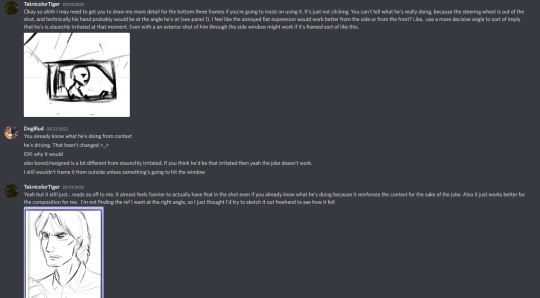
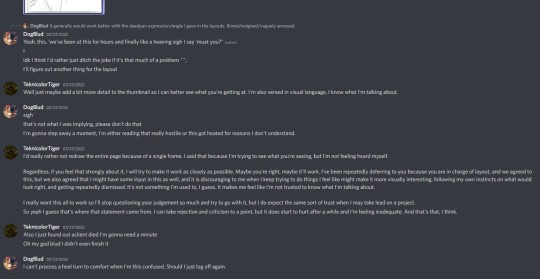
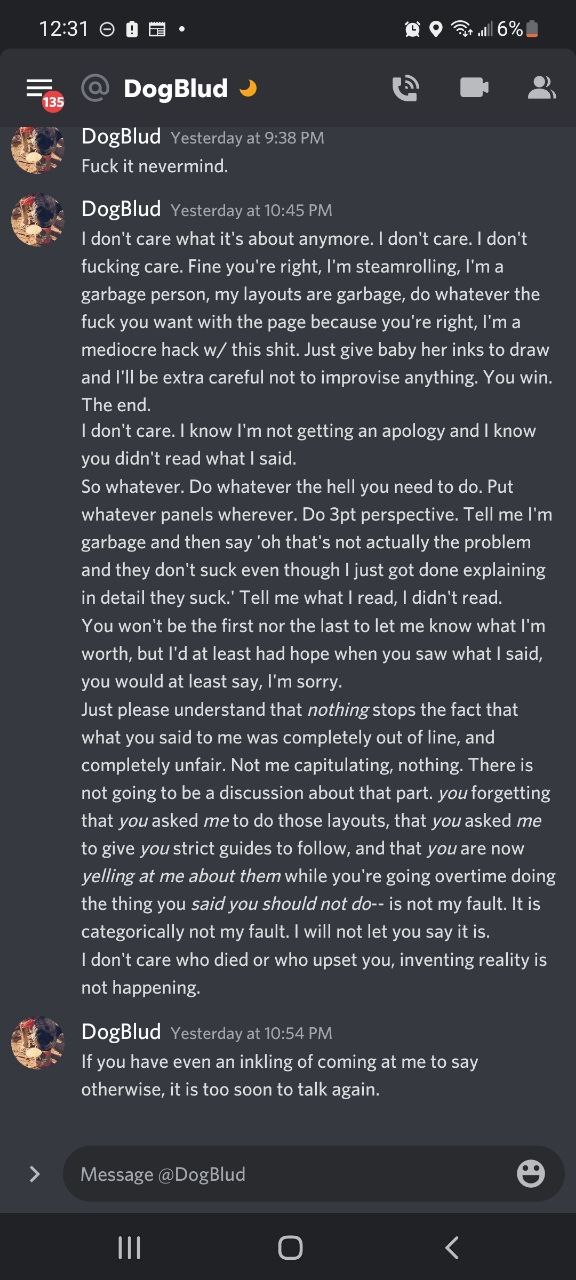
I had taken this screenshot on my phone after I had stepped away to compose myself. Blud had handled the confrontation and criticism with a reasonable amount of apprehension. But what had not occurred to me was that I could have said something that would remind her of past experiences with a roleplaying group.
It was something that had evidently scarred Blud for life.
I took away the wrong things from what she had told me, choosing to focus on the aspects of the "betrayal" that had appeared to bother her the most. And in hindsight, I did not see the correlation. I was genuinely apologetic that I had hurt her feelings.
But I *will* critique Blud for her poor handling of the situation. Whether or not I had hurt her feelings, no one is entitled to act like this or claim that this is what attempting to resolve a problem should look like.
I wasn't sure on how to initially respond to Blud. It had been ages since I'd had to deal with someone flying off the handle like that.
The following screenshots are where the conversation picked up, after she had already deleted the above message:
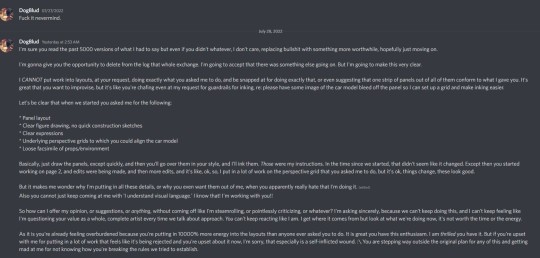
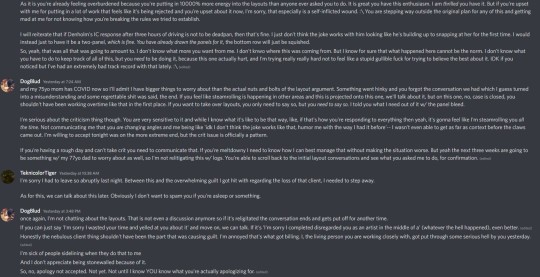
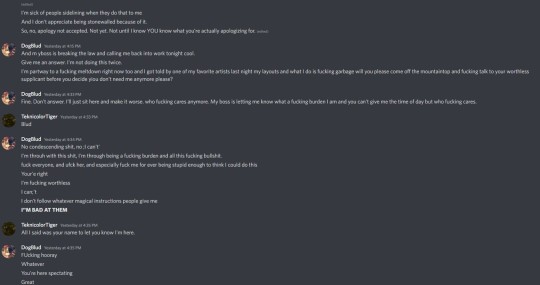
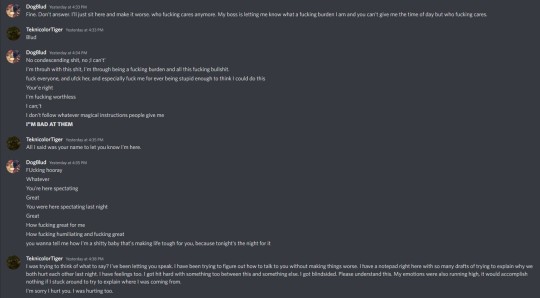
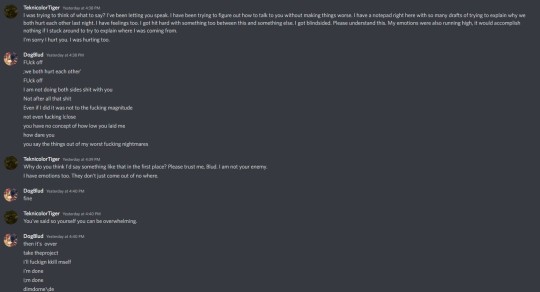
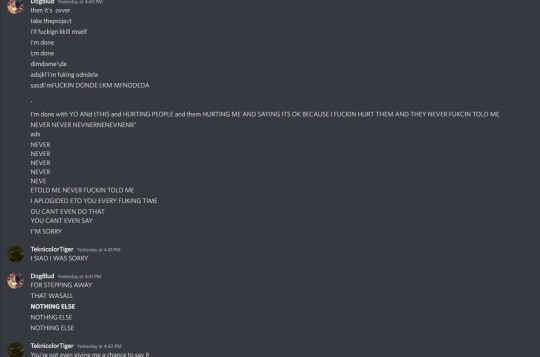
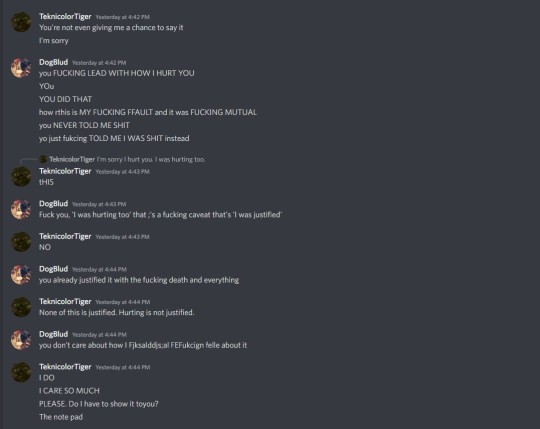
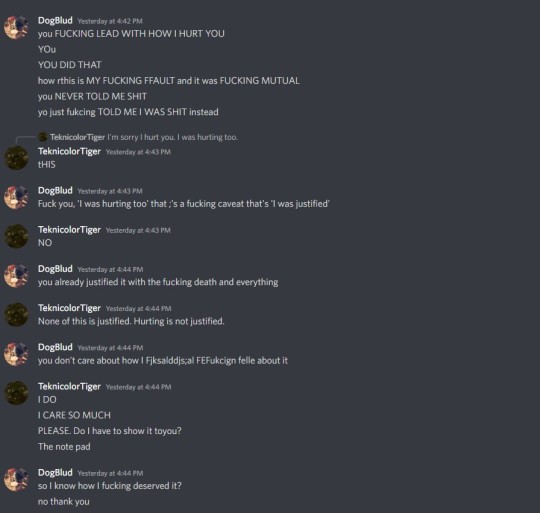
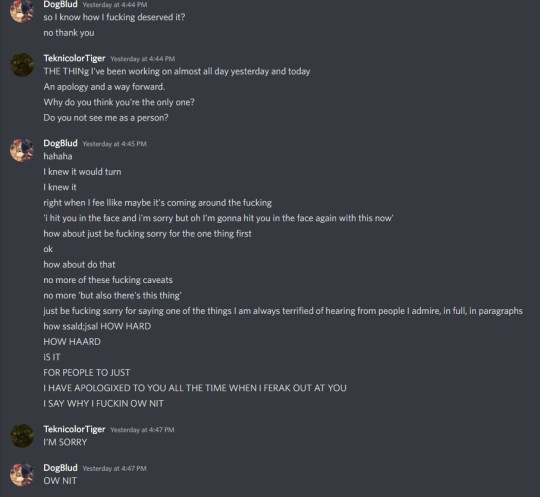

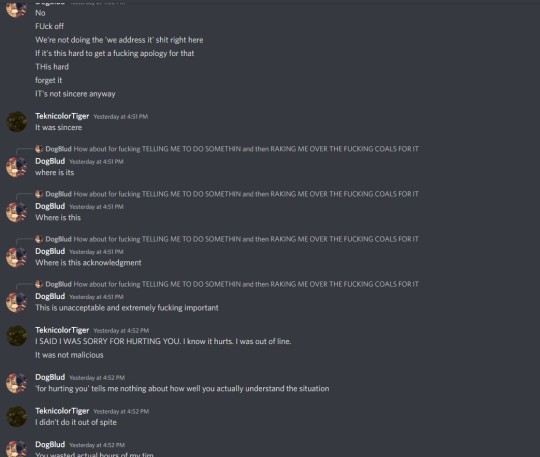

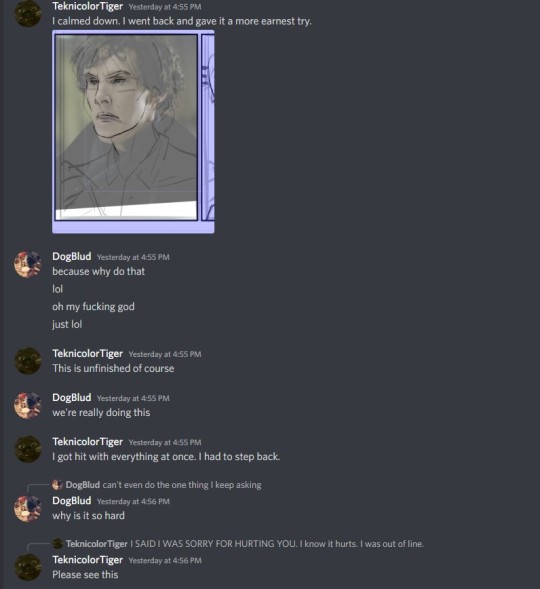
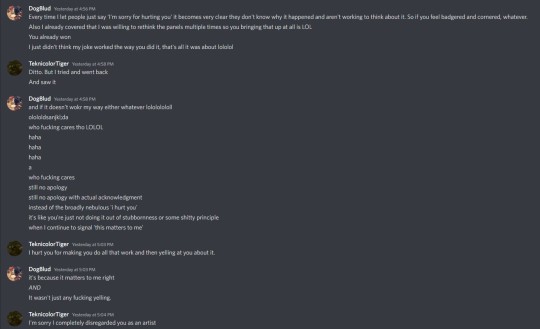
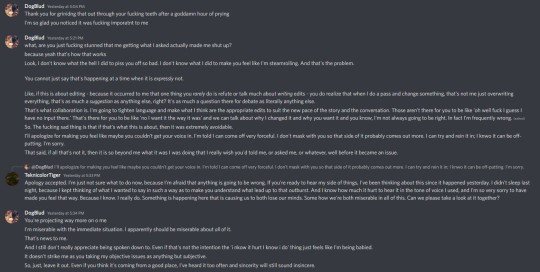
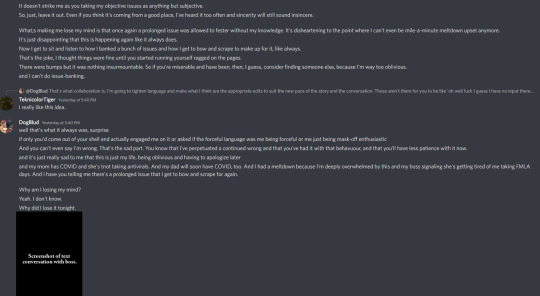
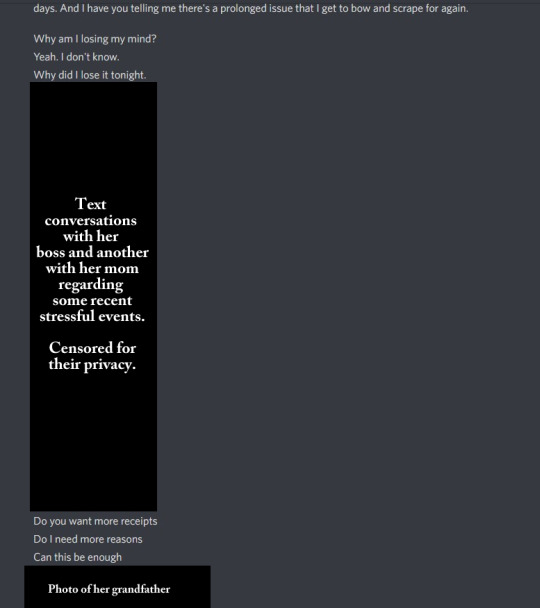
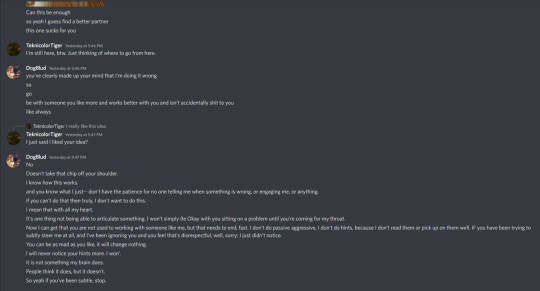
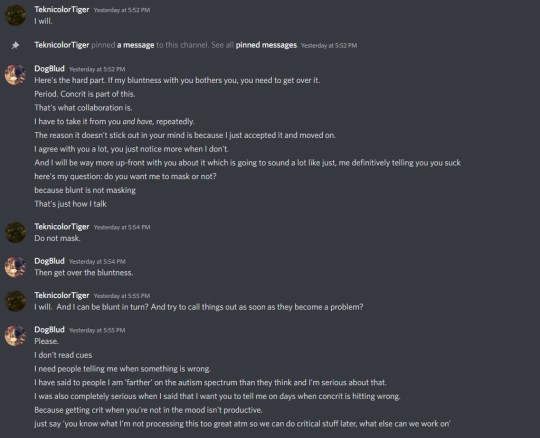
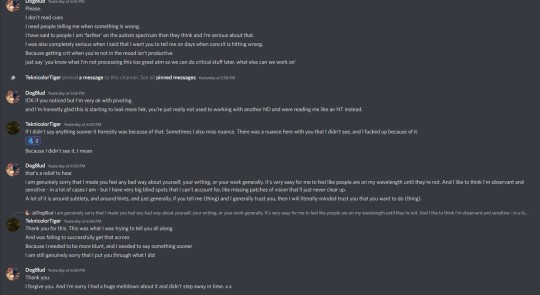
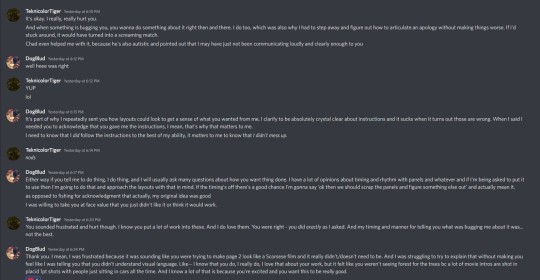

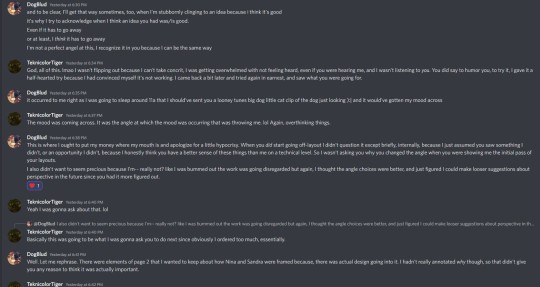
We had weathered the "storm" and after Blud calmed down, she was ready to communicate. There was a part of me that was genuinely sincere when I apologized to her. I did mean it when I said that I had no intentions of hurting her and that I hadn't considered how my statement would sound to her.
I had hoped that this had been a stress response due to factors outside of our collaboration. And especially when I took into account how she had interacted with me in the past. I knew that Blud had a lot going on IRL, and that she had already put a considerable amount of energy into this project.
I had taken her meltdown more personally than she could perceive that I would, because this was something that was acceptable to her. She had a "condition" that would absolve her of these abhorrent meltdowns and I needed to get used to them if we were going to continue working on that project together.
I was shaking the entire time we were typing in the chat.
I was sincere in my responses. I really did want to work things out with Blud and give her the benefit of the doubt. I could have been taking the things that she said too personally or maybe I had been reading too much into the situation. Was there a chance that I could have been misreading her outburst? I tried my best to keep an open mind though I was still somewhat baffled by the fact that she would have meltdowns as often as she did.
I confided in my husband and some other friends about the situation. They were also bewildered by Blud's actions.
By this point, I was struggling with the reality that this collaboration was most likely *not* going to work out but I still wanted to try. I still cared about Blud. We would still hang out together and talk about things like music, our characters, or our stories.
While I did have the foresight to go back and screenshot this section, I wasn't fast enough to get screenshots of everything else that I will be going over. Blud *did* admit to going back and deleting certain exchanges due to a mixture of shame; not wanting to look at them when she would scroll through our conversations.
In retrospect, it was very telling.
And even after that meltdown, I still enjoyed the friendship that I had with her. I kept my guard up but I was willing to make compromises on her behalf if it resulted in better communication between the two of us. Blud made me promise to immediately tell her if I had a problem with something. I also agreed to keep notes of our conversations.
It worked for the most part.
In the end though, it became apparent that Blud wasn't willing to do the same for me (even after we had an extended conversation about it). I then realized that I had been tasked with basically *managing* her autism for her. I was already busy with my supposedly "bad memory" at the time; and Blud was more than ready to scroll back up through our conversations to cherry-pick a line or two of text to remind me of what was said earlier.
Because, for her, circumstances couldn't ever change. If they did, it would mean that Blud had lost control of the situation and that she was in the wrong. She could *not* be in the wrong.
And if she was in the wrong? It would take solid evidence, three witnesses, and a court of law to prove it.
She had two other major meltdowns after this. I managed to step away from communicating with her through one of them and I don't remember the other meltdown lasting very long. She immediately deleted the texts of both of those instances before I could take screenshots of them.
It seemed like I could do nothing right when it came to Blud, no matter the lengths I would go to accommodate her. I knew that it was a common tactic used by abusers. I finally accepted that our partnership wasn't going to work out and I began thinking about an exit strategy. The final straw was when she began to expect me to be at her beck and call.
I had promised that I would be there for her, within reason, and I was willing to offer reassurances whenever she would ask me for them. The promise had been made back when we had first started to talk to one another with more frequency, before Blud had shown me her true colors. I would end up completely underestimating just how badly she would need reassurance.
To be frank, I underestimated a lot about Blud in the beginning.
I would end up mentioning that I enjoyed my space in several different conversations with her. That there was a chance that I might be offline for several days so I could take care of things IRL and recharge my social batteries. I'm somewhat of a recluse. And an adult who enjoys things that aren't online.
She said that it was fine.
I became incredibly anxious when I would talk to Blud, especially after her somewhat abrupt change in personality.
I then attempted to put my foot down about boundaries and this is what she had to say:
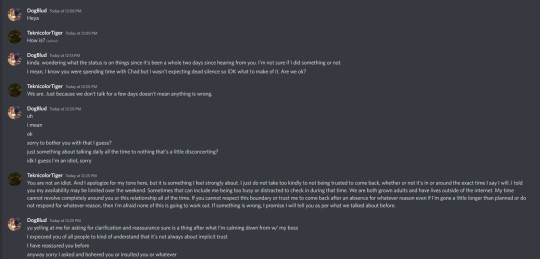
I decided to walk away for a bit and I came back after I had had some time to think things over. This wasn't healthy for either of us. I wrote a couple of sentences to say goodbye to Blud before I blocked her. I knew that my actions would probably infuriate her. She had told me in the past that she *hated* not being able to have the final word... which she was able to do through email:
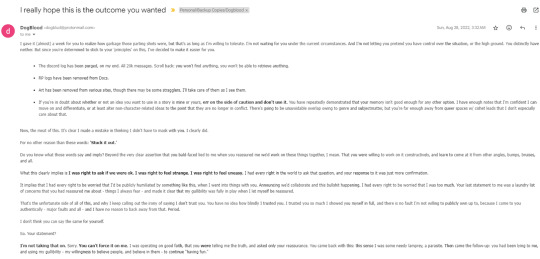
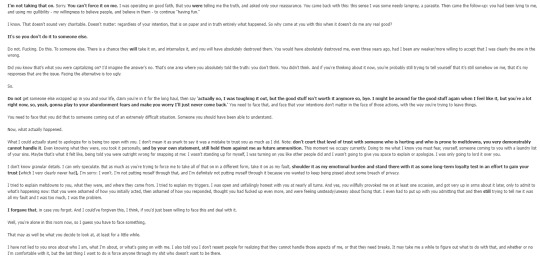
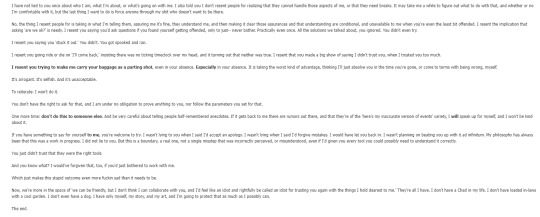
“And I'm not letting you pretend you have control over the situation, or the high ground. You distinctly have neither. But since you're determined to stick to your 'principles' on this, I've decided to make it easier for you.”
She thought that she was absolved of all sins just because I had said that I would stand by her at her worst. And at the time that I said that, I had no idea that her worst would be her trying everything possible to protect her boundaries while stomping all over mine. It didn't matter what she said or how often she would apologize when I would confront her. She kept doing it.
I admit that I wasn't perfect in this situation either.
There were times when I was condescending, critical, or downright mean when I talked to Blud because that was the way I had felt when she was talking to me. I soon realized that it didn't matter either way. I could have been using the friendliest tone imaginable and she still would have perceived it as either mocking or dismissive on my end. There were even a few times where I would preface my explanations with an advisory “please know that I am not attacking you and try to read this in an understanding tone,”etc. I would then post an explanation I had spent hours picking at to ensure that there was no way she could misinterpret the intent. Even so, she still read the majority of what I said as criticism and would take it to heart.
I never expected Blud to do something that made her uncomfortable; nor did I expect her to overextend herself when it came to our project. I would go out of my way to make sure everything was fine when we would talk about it. I only expected mutual respect in return.
When we would get into discussions (arguments), she would never attempt to understand my point of view or let me explain myself. It would have made it about me when it should have been about Blud and her needs. She sometimes would agree to come to a compromise about something, but only if I would admit that I was in the wrong.
I know that if Blud was to look at these screenshots, she'd be incredulous that I'm trying to distract from the horrible things that *I* did. And those horrible things that I did? I tried my best to work with her.
It wasn't just her poor teamwork that bothered me. It was her attitude and the lack of respect that she showed me. She would never ask me to clarify something that I said; always assuming that it was a criticism against her. I can only speculate that Blud did not want to hear about how any of this was her fault, like in the email she sent me.
I don't know if I was actually her friend at any point. Friends make efforts to understand one another. Ideally, they’d want their friendships to continue, and they would want everyone to be getting along and having fun. She seemed to actively defy that.
I would argue that things like this don't just happen in a vacuum. There's almost always a reason for such things, but it's honestly a mystery to me as to where this vitriol comes from. I don't know why Blud sees monsters in every word, especially if they come from a "friend".
I've seen her viscously mock herself during meltdowns; it seems like she hates herself and expects everyone else to hate her too. I think that she wants it to be the truth, so that it validates the feelings she has about herself. The behavior patterns that I'd been exposed to are consistent with the idea that Blud is seeking confirmation about the personal assumptions she has about herself. It's what makes her so volatile to those around her. Yet, she refuses to break the cycle.
I hope that she can make that choice in the future but at this point, I'm not holding my breath.
#dogblud#it feels a bit dirty doing a call out post#but people need to know#she's gotten away with this for far too long#i generally tend to give people the benefit of a doubt#clearly too much#but you can only make up so many excuses before you begin to realize that#at the end of the day#people still have the ability to make a choice#“everyone always leaves me”#well maybe you should really consider what the common variable is#just sayin
259 notes
·
View notes
Text
I went into this a little in this post, but here’s how I categorise our resident Curufinwës + what their strengths in war are.
Fëanor: The Scientist. Aggressive.
Curufin: The Architect. Defensive.
Celebrimbor: The Inventor. Protective.
Fëanor: The Scientist. The Silmarils were all about the science. How to hold light. What materials are needed. How to make it stronger etc etc. Feanarian lamps honesty give me lightbulbs on steroids vibes, very sciency. He created the alphabet and no doubt numerous other things. In general Fëanor is said to want mastery over things and minds. He wants to understand then use that knowledge. He’s experimenting with known variables and pushing them to their limits.
(If he lived) his strength would be aggressive weaponry and tactics, creative mind pushing for stronger, faster, more accurate but more destructive weapons. He brings people into a passionate rage to give them the strength to go on.
Curufin: The Architect/Pragmatist. in my head is all about building on things. He also has that spark but he makes unbreakabke battlements. Bridges. Weapons. Armour. Fortresses with so many nooks and secret passages and extra defences only his brothers can keep track. He’s crafty, he’s smart. He knows how to trick people into seeing one thing and it being something else. To create false chinks in armour and defence that will be targeted and hold up, and give his people a chance to fight back while the attacker thinks he’s won.
All this means he’s great at providing defensive structures. Give him a basic fortress and he’ll create all kinds of pathways to escape and areas great for attacks and ambushes. Fool enemies and give them the element of surprise. He holds the line.
Celebrimbor: The Inventor. The rings are so unlike anything we’ve ever seen, and unlike Fëanor’s Silmarils they have true power to them. They protect and shield and raise rivers and give longevity and hold life still for the elves unused to change and so much more. He creates his city as a place for students, has a whole sect in the Gwaith-i-mirdain who learned and experimented and would create new and wondrous things. Were canonically the best artisans since Fëanor himself, led by Celebrimbor. He created so much that there was no way to even think of replicating it after he and his people were killed, and the knowledge lost. This wasn’t science. This was something entirely new. And they never saw it again.
All this means he can create invisible barriers as protection so people can live well on the daily. Keeping people safe and well is his top priority.
But yeah this is why I hc that Maedhros’ prosthetic was the combined effort of Celebrimbor and Curufin. Tyelpë was still fairly young, but he had that creativity to know how to make a working hand buried with enchantments and the like. Curufin worked out the mechanics of it and made sure it would be functional for daily life and as a weapon.
Fëanor ofc is dead by now so he doesn’t get to do much, but you best believe he’d add all kinds of sleek weaponry so his eldest could protect himself.
#Fëanor#fëanorians#feanaro curufinwe#Curufin#curufinwë#Curufinwë atarinkë#atarinke#celebrimbor#tyelperinquar#tyelpë#house of feanor#Silmarils#rings of power#silmarillion#tolkien#silm headcanons#silm#feanorians#to accent or not to accent#remains the question#Maedhros#Maitimo#nelyafinwë#on Curufinwës
76 notes
·
View notes
Text
Neptune In ♈: the 12 Houses
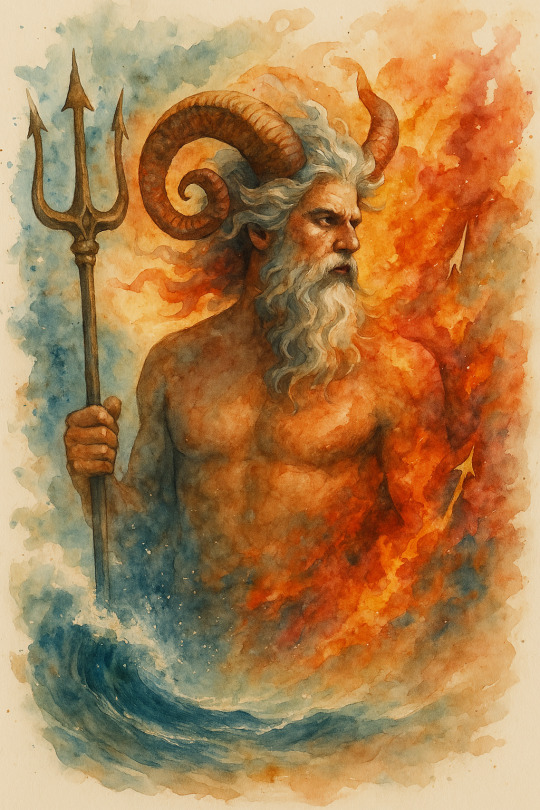
House 1: Self & Identity Neptune in Aries here casts an enchanting glow on your persona. With Neptune’s dreamy mystique fused with Aries' pioneering energy, you are an effortlessly magnetic, innovative soul. This placement invites you to embrace an evolving self-image, though it may sometimes be hard to pin down where your true boundaries lie. ✨🔥
House 2: Finances & Values In the 2nd house, Neptune in Aries brings an imaginative approach to money and self-worth. You might feel impulsively driven to invest in creative or spiritual pursuits, yet caution is needed to avoid chasing financial illusions. This transit encourages you to redefine value in terms of inner fulfillment, not just material wealth. 💸🌠
House 3: Communication & Learning With Neptune’s ethereal touch in the realm of your immediate environment, everyday communications and learning take on a creative, intuitive edge. Aries’ influence adds spontaneity and directness, making your conversations vibrant and full of inspired ideas. Just remember to ground your thoughts to avoid getting lost in airy distractions. 🗣️💭
House 4: Home & Foundations At home, Neptune in Aries blurs conventional boundaries, encouraging you to craft a domestic space that’s as fluid and unconventional as your inner world. Here, the impetus for change is strong, prompting you to reinvent what “home” means while being mindful not to lose sight of genuine emotional anchors amid fantastical visions. 🏡🌙
House 5: Creativity, Romance & Fun In the creative playground of the 5th house, Neptune in Aries ignites a burst of inventive energy. Whether it's your art, romance, or hobbies, expect a dash of magic and spontaneity. This mix can create dazzling, impulsive expressions—but balance is key so that the allure of the dream doesn’t outshine clarity in relationships or projects. 🎨💖
House 6: Work, Health & Daily Routines Neptune in Aries here makes your routine a vibrant, sometimes unpredictable arena. You’re drawn to innovative or alternative approaches to health and work, often feeling the call to break free from monotony. It’s crucial to structure these energies to prevent drifting into unproductive daydreams while enjoying bursts of inspiration. 🏋️♀️🌈
House 7: Relationships & Partnerships In the realm of close relationships, Neptune in Aries sparks passionate, if sometimes idealized, connections. You enter partnerships with a fiery desire for independence and transformative love. However, clear communication is vital to ensure that the luminous haze of Neptune doesn’t lead to unrealistic expectations or blurred boundaries with partners. 🤝💫
House 8: Transformation & Shared Resources This house deals with deep emotional processes, shared assets, and transformation. Neptune in Aries here can trigger bold, sometimes dramatic shifts. You may experience intense, almost mystical changes in intimate relationships and financial entanglements. Embrace these periods of transformation, but be careful not to let illusions dictate your trust and shared ventures. 🔮💥
House 9: Philosophy, Travel & Higher Learning The combination of Neptune’s visionary spirit and Aries’ adventurous spark in the 9th house inspires an unconventional journey through belief systems and global experiences. You’re likely to champion new, perhaps radical, philosophies and explore far-off lands with a thirst for insight. Keep an open mind while staying anchored in discernment to avoid spiritual overreach. ✈️📚
House 10: Career & Public Image Neptune in Aries energizes your public persona with creative ambition and visionary drive. Whether you’re drawn toward the arts, healing, or innovative entrepreneurship, this transit propels you to redefine success in pioneering ways. Ground your dreams in practical steps to sidestep the pitfalls of chasing illusions in the spotlight. 💼🔥
House 11: Community & Aspirations Here, Neptune inspires you to dream boldly about your future within social groups and networks. Aries infuses these dreams with the courage to challenge the status quo and pursue groundbreaking projects. While your friendships and community endeavors may brim with idealistic visions, clarity and realistic planning will help you build sustainable, transformative relationships. 🌐⭐
House 12: Spirituality & the Inner Realm Neptune naturally feels at home in the 12th house, and with the passionate push of Aries, you’re invited to embark on deep, fearless inner voyages. This placement can unlock profound intuitive insights and spiritual awakenings. Balance is crucial: use this energetic drive to explore your subconscious without slipping into escapism or unfounded fantasies. 🌌🔍
Neptune in Aries across the 12 houses creates an inspiring blend of dreamlike vision and assertive action. It beckons you to pursue your path with innovative flair while gently reminding you to maintain balance and clarity amid the cosmos. Whether it’s reinventing your self-image or daring to challenge established norms, this transit provides a space to transform, inspire, and dream with purpose.
#astrology#astroblr#astro posts#astro placements#astro notes#astro community#neptune in aries#aries placements#neptune planet#neptune rambles#astro witch
42 notes
·
View notes
Text
💕Understanding Signs🧚🏼♀️
🥊Fire element-fire suggests to many the intuition function. This is because fire tends to perceive in pictures, and to get an instantaneous grasp of a situation. Fire does not reason or think in any classical sense of the word: it either understands or it doesn't. This is why fire people can be extremely creative yet not good at logical reasoning. People with a lot of fire energy have a great impulse, which is sometimes difficult to control. They often make a decision all at once and quickly. They don't like waiting.
They perceives things through pictures and sudden flashes of insight. A fire person will study something for a long time without comprehending it, and then the significance will become clear in an instant. Fire is often psychic, in the ordinary meaning of the word. Fire is the most positive or yang of all the elements. It is the energy of spirit, and operates within the universe by energizing and transforming. It is not characteristic of fire to work along lines already set, or to respond to energy patterns that are imposed from without. Fire rises: it cannot stay at one level for long. This gives fire people a dramatic, intense quality. They do not enjoy standing still.
Fire element-fire is an emotional element, but it tends toward the more active and dynamic emotions— anger, joy, ebullience, and enthusiasm. Also fire signs are very positive in everything they do. For ex.: Leo Mars - Regardless of the situation, they will always want to cheer someone up with a funny show or put on a show to make the person happy again. Leos in general always have an inner child (they will always be ready to watch cartoons with you). Sagittarius Venus-They will be the best at helping you through a difficult breakup. They always find faith in life and know how to find meaning even when it is difficult to see it. They have a special charm with which they always bring people good mood and instill hope. They will never stop believing. Aries Sun- will always be ready for action. They are not afraid of dangerous things and like something that is more risky. They are the only sign that is rarely afraid, usually they will be the ones who will be the bravest. They have harder time dealing with sadness, depression, or the kind of feeling that comes from quiet contemplation of one's surroundings.
Fire people do not like to show sadness or grief: their typical response is to make fun of their own unhappiness. Even when they are down, they are often capable of making others feel better. Being an outgoing, positive energy, fire does not easily play passive roles.
Earth element- earth signs are most concerned with perceiving an external, physical reality. But earth is not simply concerned with perceiving it, it is also concerned with ordering it in the way that is most effective in a given situation. Earth signifies concern with the physical, with practical, common-sense matters. Earth is a symbol for direct sense experience of the physical universe, without ideas, concepts, beliefs, or wishful thinking to cloud perception. Thus matter, and through it the symbol earth, signifies limits to our freedom in which regard the element earth is related to the planet Saturn).
Unlike fire, earth is stable, the most stable of all the elements. Also unlike fire, earth is passive: it needs to be acted on and formed by an external energy. For earth people to be really productive, there must be a positive, assertive energy provided by the planetary combinations in their charts.Otherwise, the earth type of personality remains passive.
Taurus is a sign who will give you a lot, spoil you, buy you gifts, take you to a luxury hotel, take care of you. They do a lot related to money. They are a sign that will spoil you with material things and may not be so creative themselves. But they also know how to be selfish and stubborn and do not care about your feelings.
Earth tends to resist change, and it can signify structures that break down under pressure because they lack the flexibility that allows adaptation.Earth signifies making do with what is available. Earth people are adept at dealing with the details that must be attended to in everyday reality in order to make it work effectively. Being a relatively passive element, earth perceives better than fire. Earth people are usually close to their gut reactions to life. Inner experience is valued less highly by the earth temperament, because earth tends to focus its perceptions externally.
Virgo and Capricorn especially are inclined to sacrifice emotional needs when these come into conflict with their view of reality. Although Capricorn looks like a cold sign and people wouldn't expect it to have so many emotions and make sacrifices for others - in fact it does. Capricorns often sacrifice their time for the people they love and can build a relationship for years and years, even if it ends up not being what they might have wanted. A Capricorn can have a lot of work and responsibilities, but still finds time to see you or cook you lunch, do something practical for you. Virgo it is often seen as a judgmental and sometimes not so accessible sign (a sign that gives you the feeling that they don't like something or that they are angry). But in reality, they are a sign that cares a lot about others-they will always be ready to take care of you.
Air element-Like fire, air may be more concerned with things that are not yet real, that are abstract and unrelated to a given reality. Air is as concerned with the relationship of things in the outer world as earth is, but air is more interested in abstractions. The difference between the symbols fire and air can be seen in the difference in the behavior of actual fire and wind. Fire rises, whereas wind moves horizontally.
Like fire, air can become so involved in abstractions that it loses touch with physical reality and practical considerations. But unlike fire, air hovers just above the Earth's surface, so that though it is fond of abstractions, the abstractions are closer to physical reality than those of fire. Air is associated with thinking and logic, and as such it is less personal than fire. Fire is usually connected with the vital, personal drive, or the will, and the abstractions are one's personal abstractions. But air, which has a social, external conception of truth, is more inclined to abstractions that have little to do with the individual.
In this way air is similar to earth: both are primarily concerned with a reality external to the self. Fire and water are more concerned with personal, inward kinds of truth.
Air always has a strongly social quality. All three air signs have to do with relating to others— Gemini to the immediate world through mind and speech, Libra through achieving perfect balance within a one-to-one relationship, and Aquarius through group consciousness and interaction.Air lacks fire's ability to go off on its own to be itself.
Aquarius as a sign of revolution, it is related to revolutionary movements, not non-conforming individuals, thinking in a different way, breaking the rules. Aquarius desire freedom to impose their ideals on society as a whole. Gemini they like to open different topics, talk long into the night. Their thoughts are quick and unpredictable. But they often have problems with getting attached to someone. Although air is very social, it is sometimes unable to handle real intimacy well. This is because air operates extensively, rather than intensively.
Libra is the only air sign in which the drive for close, personal relationships is strong, but even here there is a detached, non-intimate quality often obscured by the cleverness of the sign.
Water element presents the greatest difficulty. But even though water may feel good or bad much more quickly and sensitively than the other elements, it is no more judgmental as to whether something may be good, bad, pleasant, or unpleasant. Of the four elements, water is in some ways the most difficult to understand. Water is the most yin of the four elements, and the most bound up in the maternal, feminine archetype which is so poorly expressed in our culture.
Strongly watery people who comprehend this element from first-hand experience cannot readily communicate what they comprehend. Water people are poor at communication or unwilling to communicate. It is just that what they have to communicate is extremely difficult to put into words.
Scorpio communication is difficult because water represents non-linear, non-rational, non-discriminative modes of thought-the very antithesis of air. Fire and water both represent non-rational functions, but fire has more to do with sudden, lightning-like comprehension, whereas water has a subtle, feeling- toned understanding that comes into being at no particular point, seeming rather to have existed always.
Water is the best at feeling relationships and the ways every thing interacts with every other thing. Water may see and understand in a way that is hard for the other elements, especially air, to comprehend, but it sees very well.Often the best way for water to communicate is by means of art, especially poetry and music. Water people usually are artistic. Another factor that sometimes places a barrier between water and other elements is that water experience is very personal. In this respect water is nearer to fire, and more distant from air and earth. Water people's personal experience can be so vivid that external reality fades into insignificance beside it.
Pisces are very artistic and also the most dreamy sign of all water signs.They have their heads in the clouds most of the time and are also the sign that is the most naive. Cancer is the most family-oriented and caring sign. A sign that also prefers to spend time with people close to it. They like to be in their comfort zone. Scorpio is the most mysterious, the sign that fights the most. Is also the most private sign and doesn't like to share his stuff with others. It is a sign that has a problem with trust. Scorpio is also very deep sign.
Water is a symbol of empathy. Empathy is the ability to feel what another feels as if one were that other person. A water person understands feelings and emotions better than any other elemental type, and is capable of great emotional depth and compassion for others. Men in particular have a problem with the water parts of their nature because watery qualities are so out of accord with masculinity. Water people often have stronger ties with the past, a stronger involvement with familiar people, places, and situations. In a strong water person there is the protective, maternal streak; in a weak water person, there can be emotional grasping and possessiveness. Water has a need to self-dramatize like fire; but unlike fire, water is willing to take other people's emotions seriously as well.
🎸For personal readings u can sign up here: https://snipfeed.co/bekylibra 🎸
-Rebekah💍🦋🌙
271 notes
·
View notes
Text
Hey Look At This... Comic? The Timekeepers of Eternity




Motion comics were a bit of a bust huh? Oh, there's examples here and there, especially when talking about independent weirdo hypercomics, of works that incorporated motion convincingly and compellingly, but most corporate offerings amounted to taking still images and having their panels slam across the screen, pile on top of each other arbitrarily, or fade into view one at a time accompanying voice acted lines--the worst of film, comics, and audiobooks combined. Easy enough to explain: paying people who work exclusively in print comics to do (or adapt) a "motion comic" just isn't going to result in much latitude or incentive for bold formal experimentation, nor does it play to the training of the artists handed the task.
On the other side, there's the real structure perverts, mad scientists of comics. They face the same problem as every other avant garde artist: how do you get paid? Where does your audience come from? Criticism for comics in general is underdeveloped; criticism for webcomics and hypercomics even more so. Launching what by necessity must be a more fine arts oriented career in what's still widely understood to be mass market commodities seems daunting, as does coaxing a mass audience out of its comfort zone.
It makes some sense, given all that, that one of the best showcases of the potential of motion comics would come not out of comics itself but the weird and heady film fan edit scene. Blessed with an abundance of material to work with (especially in the cases of franchises, miniseries, or films with extensive cut content or rereleased versions) fan editors have a latitude to screw around without having to produce a bunch of raw footage or drawings themselves (though, the nature of enthusiast projects does inspire people to do things like, say, redo all the special effects from Alien3).
There's certainly a mountain of frames to work with in the Langoliers miniseries from 1995. Probably an overabundance, actually. That's great for Aristotelis Maragkos, though, whose recut of the miniseries into the tight hour long experience The Timekeepers of Eternity needs a lot of raw matter.
I actually mean that literally: Timekeepers is a film produced by physically printing out photocopy versions of the miniseries' frames, manually altering them, re-photographing them, and re-cutting the audio to fit the new narrative. Its runtime is partially achieved by layering scenes onto each other, so actions happen in parallel, or characters expound on a subject while a pan of the environment fills in detail. Sometimes, astonishingly, footage of cloudy skies becomes an abstract 2001 style gradient as characters get lost in their own thoughts, or staring eyes from a close up rip eerily into a shot of a still landscape. What another compressing edit might discard, Maragkos collages back into the frame in unexpected ways.
This could be just a fun gimmick or novelty, and can occasionally come across as just a fun flourish on an otherwise kind of awkwardly acted and plotted original. But just as often Maragkos finds incredible possibilities in the strange hybrid medium. There's a shot early on of Toomey, the murderous time-obsessed business boy going through a breakdown, that blew my mind and immediately convinced me of the film's vision. Toomey, who pitched a tantrum when the plane failed to reach his board meeting in Boston, gets his nose nearly broken by another passenger. Outmatched, he retreats, resentfully, turning and walking back through the plane. As he does so, the film tears, creating a multiframe of instances of Toomey looking back, petulant tears in his eyes.

What happens when you turn a film into a comic in this way? In a static comic, splitting up this action into a series of "prolonger" panels helps clarify small movements and draw out the action, but in a film that's not really necessary. we can just watch that sequentially in time, like we do in real life. What else does this breakdown do in a comic? It can heighten a moment, suggest a psychological intensity, a kind of distending of time or hyperreality. Isn't that exactly what's happening for Toomey? He retreats, literally--we watch him do it. Yet he remains in place simultaneously, staring, seething. He might physically go, but psychologically he is still rooted in place, boiling over with anger at his rough treatment.
Shortly after this scene, we discover the textual rationale for Maragkos's bizarre aesthetic endeavor: Toomey has a bizarre tick of his own, am almost eroticized need to stim by tearing and shredding paper. As he sits and stews after another confrontation with the rest of the passengers, he tears at a magazine, and the screen tears too, layers of the frame peeling back to reveal other elements of the scene, so that his tearing becomes the ubiquitous context for the other characters talking about him and around him.

I have a lot more to say about this one so I'll cut the review short here and you can read the rest on my full blog. You can also read the rest of my Hey Look At This Comic reviews on tumblr, and support me on Patreon.
#Hey Look At This Comic#comics#hypercomics#fan edit#the langoliers#stephen king#the timekeepers of eternity#horror#horror recs#horror review
33 notes
·
View notes
Text
DAY 5974
Jalsa, Mumbai June 26/27, 2024 Wed/Thu 12:56 am
🪔 ,
June 27 .. birthday wishes to : Ef Ravi Patel .. Ef Diyansh Kumbhat from Chennai .. and .. Ef Ayush Mishra from Bilaspur .. 🙏🏻❤️🚩
💍 .. wedding anniversary greeting to : Ef Rajesh Kejriwal from Kolkata .. completing 35 years of togetherness .. on June 26 .. our wishes and more .. 💐🙏🏻❤️🚩
..
Birthday - EF - Ravi Patel Thursday, 27 June our wishes for this day and the best ever .. love ❤️
Resistance .. its many forms and values and dimensions and usage .. so it became urgently important to apprise the self of it from sources ..
"Resistance is a multifaceted concept, encompassing physical, psychological, social, and political dimensions. Its definition and application can vary significantly depending on the context in which it is considered. At its core, resistance involves the act of opposing, withstanding, or striving against some force or condition. This broad definition can be applied to various fields, including physics, medicine, psychology, and social movements.
In physics, resistance is a measure of the opposition to the flow of electric current in a conductor. It is quantified by the unit ohm and symbolized by the Greek letter omega (Ω). The resistance of a conductor depends on its material, length, cross-sectional area, and temperature. For instance, materials like copper and aluminum have low resistance and are therefore good conductors, whereas materials like rubber and glass have high resistance and are good insulators. Ohm's Law, a fundamental principle in electrical engineering, states that the current flowing through a conductor between two points is directly proportional to the voltage across the two points and inversely proportional to the resistance. This relationship is crucial in designing electrical circuits and understanding their behavior.
In medicine, resistance often refers to the ability of microorganisms, such as bacteria and viruses, to withstand the effects of drugs that are intended to kill or weaken them. Antibiotic resistance is a significant public health concern, as it makes infections harder to treat, leading to longer hospital stays, higher medical costs, and increased mortality. Resistance can develop through various mechanisms, such as genetic mutations or the acquisition of resistance genes from other bacteria. The overuse and misuse of antibiotics in humans and animals accelerate this process, making it imperative to use these medications judiciously and to develop new treatments.
Psychologically, resistance can manifest as a reluctance or refusal to accept certain thoughts, feelings, or behaviors. This concept is particularly relevant in therapy and counseling, where clients may resist discussing painful or traumatic experiences. This resistance can be conscious or unconscious and can hinder the therapeutic process. Understanding and addressing resistance is crucial for therapists, as it can provide insights into the client's internal conflicts and defenses. Techniques such as building a strong therapeutic alliance, using motivational interviewing, and gradually exposing clients to difficult topics can help in overcoming resistance.
In social and political contexts, resistance is often associated with efforts to oppose and challenge established power structures, policies, or social norms. Throughout history, resistance movements have played pivotal roles in advocating for social change and justice. Examples include the civil rights movement in the United States, the anti-apartheid struggle in South Africa, and the women's suffrage movement. These movements often involve a combination of nonviolent protest, civil disobedience, and sometimes armed struggle. The success of these movements typically depends on various factors, including leadership, organization, public support, and the ability to adapt to changing circumstances.
In contemporary times, resistance continues to be a vital force in addressing issues such as climate change, systemic racism, and economic inequality. Activists and grassroots organizations worldwide are mobilizing to resist policies and practices that they perceive as unjust or harmful. Social media and digital communication have transformed the landscape of resistance, enabling rapid dissemination of information, coordination of actions, and amplification of marginalized voices.
Resistance, in its many forms, is an essential aspect of human experience and societal development. Whether in the realm of science, health, psychology, or social justice, resistance challenges the status quo and fosters progress. It embodies the struggle for survival, dignity, and betterment, reflecting the resilience and determination inherent in individuals and communities. As such, understanding and engaging with the concept of resistance is crucial for addressing the complex challenges of our world. "
... and at times the sources do not even address the most common of them all in the resistance ..
It be the pen and paper writing ..
When the pen has a resistance to the paper quality it is being written on the writing experience is determined as good bad or average ..
When the holding posture of the pen is conveniently comfortable to write, it produces the quality of writing exhibited ..
When the nib and flow of the ink on the pen is of desired like , the paper may be of the best resistance quality, the writing shall never be of the desired ..

paper same .. nib different , pen different .. sign same , but all different in form and appearance ..
GN 😴

Amitabh Bachchan
94 notes
·
View notes
Text
Ecology Entry - Windward Plains - Ceratonoths and Nothpeckers
One of the most common animals found in the Windward Plains are the herbivorous small monsters, Ceratonoths.

These shelled quadrupeds can be spotted in sizeable herds within the Windward Plains, typically around water sources and areas ripe for grazing. Herds are led by a male with multiple females, but it's not uncommon to see different herds mix together to form larger herds with multiple males. So far, no intraspecific competition has been observed between males for mating rights, however it's plausible that some form of competition or selection occur due to the structures of the herds. Combined herds typically form during the Windward Plains' season of plenty where lush grass carpets the land around large water sources making vital resources plentiful.

As mentioned prior, herds are led by a single large male identified by the sexually dimorphic characteristics that include their size, darker color, and the distinctive tall spikes that adorn their backs. Although helpful in defense against predation, the spikes' main use is as lightning rods. Due to the inclement climate of the Eastlands, the Windward plains often experiences intense thunderstorms that are characterized by high winds and deadly lightning strikes, dubbed the Sandtide. To protect the herd, the male stands within the center of the group, allowing lightning to strike it's spikes and grounding the energy, while the females and juveniles lay down, keeping their softer undersides close to the ground.
Juvenile Ceratonoths look almost identical to adult females, however it is assumed that male and female characteristics develop with maturity. Reminiscent of Aptonoth and Apceros, Ceratonoths defend their young fiercely, often forming defensive circles around their young. If this fails to drive off a larger predator, the sheer size of some of these herds acts as safety net for the young, allowing them to flee with the cover of the larger adults. The mating season seems to occur mainly during the season of plenty where higher number of juveniles have been observed.

Alongside the Ceratonoths themselves, a curious companion is often seen riding on the tough shell plates of these animals. These birds are aptly named Nothpeckers, and can be seen keeping the Ceratonoths clean of old shell material and parasitic insects. In return for the maintenance, the Ceratonoth herds provide safety and food for the Nothpeckers.

Both of these species have only been spotted in the Windward plains, however I have heard of some unconfirmed reports of Nothpeckers being spotted in the Scarlet Forest. If this true, then perhaps that's where the Nothpeckers nest for their own breeding season as the only bird I've seen roosting within the Windward Plains is the Amstrigian. These incredible animals are sight to behold to those new to the Eastlands and provide a wonderful microcosm into how life has evolved around this volatile environment.
Per Audacia Ad Ferae
#mh#monhun#monster hunter#monster hunter wilds#monster hunter world#monsterhunter#monsterhunterwilds#wilds#world#ceratonoth#nothpecker
22 notes
·
View notes